#after matthew dies an overture
Text
gingerbread
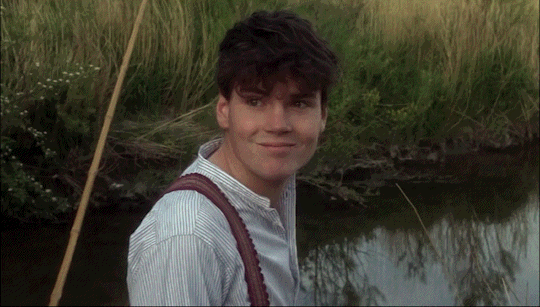
1. “What are those, Anne?” Diana asked, pointing to the pile of unevenly shaped, lumpy brown biscuits which were keeping uneasy company with Marilla’s famous cherry jam thumbprint cookies and some of Mrs. Rachel Lynde’s golden shortbread. Anne cradled the well of her tea-cup and let the steam rise up like a genie before she answered; she knew Diana wouldn’t mind waiting because she was a bosom friend and had shown it even more every day since Matthew died.
“I don’t know, to be honest, Di,” Anne said. “I found them wrapped up in a clean dishtowel in a little wicker basket by the side door. There wasn’t a letter or a card or anything to say who made them or what they were. I know they don’t look particularly appetizing, but I thought I should at least put them out before I throw them away. They made me wish we had a cheerful pig named something splendid like Hieronymus to feed them to, but alas, we only have the chickens and the cow and it wouldn’t do to put Buttercup off her feed. We’d have no butter or milk for a week.”
“Marilla would never let you name a pig Hieronymus,” Diana remarked. She picked up one of the biscuits. “I’ll try one, a little bite anyway. If it’s terrible, I warn you, I’ll spit it out in my napkin.”
“You can’t offend me, Di—I still remember all those sets of Hammond twins,” Anne said.
Diana sniffed at the cookie, then took a dainty bite, chewed for a moment and then smiled.“I know what this is—and who it’s from,” she said.
“Don’t keep me in suspense,” Anne said. “Have I a mortal enemy in Avonlea who wishes to dispatch me with inedible pastry? It cannot be a secret admirer—"
“You have a friend, you goose,” Diana said. “As soon as I tasted it, I knew what it was.”
“Well?”
“It’s the Blythe gingerbread,” Diana said. “I’ve tasted it a thousand times, it’s their own spice blend and Mrs. Blythe will never say exactly what the spices are and in what proportion. But she never made this, she’d be horrified if she even saw these, halfway to burnt. Gilbert had to have made them.”
“Gilbert?”
“It’s not that surprising, Anne,” Diana said. “He hasn’t tried to hide that he wants to be your friend and it makes sense that he’d want to give you something—but in a way that you don’t have to thank him for it. It’s true these aren’t the best biscuits, but it’s the thought that counts and it’s awfully sweet of him.”
“It is sweet, isn’t it?” Anne said, looking at the biscuits again. He only had the most rudimentary baking skills, which was understandable since he was the Blythe family’s only son, but she imagined him in the kitchen, measuring out the flour and sugar, his brow furrowed as he considered how much of each spice to add, maybe licking a smear of molasses off his thumb. “I’ll have to thank him,” she said.
“I suppose,” Diana replied slowly. “Or you needn’t. He didn’t leave a card or a note. I don’t think he expects you to say or do anything. He just wanted to do something nice for you. I don’t think he expects anything in return, not even a thank you.”
“I’ll have to return the cloth and the basket, though,” Anne said.
“You leave that to me,” Diana said stoutly, as if she were undertaking one of Hercules’s twelve labors. Anne smiled again, thinking of Diana with the basket in the crook of her arm and Gilbert finding it on his doorstep, the cloth neatly folded with little pine tassel tucked in as a talisman.
#anne of green gables#prompt fill#gingerbread#anne/gilbert#gilbert blythe#diana barry#friendship#fluff#mild angst#fruitloopsforlife#holiday#after matthew dies an overture#evening reblog#but I reposted instead of using the answer prompt#anne shirley#bosom friends
17 notes
·
View notes
Text
youtube
COMMENTARY:
Dr, McDonald does understand that the Prodigal Son is a re-casting of The Odyssey, doesn't he? The whole of the divine intent of the Biblical narrative from the Book of Job to Revelation can be summed up by the response of the Father to the sight from afar of the Prodigal Son, trudging home like a beggar. The whole Bible can be understood as Elohim the verb saying "Hi!:
When first we meet Odysseus, he is weeping, His men have been turned into swine and he is being prevented from returing to Faithful Penelope by the gods, who finally relect of their curse on him for his insolence of pride and is allowed to return to Ithaca, where his dog, Argos, who dies from joy, like a video of a soldier being greeted by his/her dog on returning from deployment,
The point Jesus is making with His Parable is that God the Father in the parable is like Argos, except he doesn't fall down dead,, but orders his household to prepare a celebration for the return of his lost child, In contrast, the elder son is resentful of his brother's resumption in the household in the same way the False Suitors must be killed in The Odyssey,
we are all lost children returning home in the sight of The One, If Paul had employed the Parable of the Prodigal Son on Mars Hill instead of his lame rabbinical legalism of the "unkown god", his presentation would have been far more successful.
All the Gospels are profoundly Hellenistic, Jesus, himself, is selling the Hellenistic Judaism of Philo of Alexandria, as presented in the overture to the Gospel of John, Jesus perfects the Shem by including Plato in the construct and includes the "love they neighbor" clause as the abicing ethic of the atheist in the Free Will paradigm of The Kingdom of Heaven. (of the Newtonian universe, in contrast to the Kingdom of God of The One as described in Revelation 4:2)
I mean, in essence, The Gospels do, indeed, rip off the Homeric epic, After all, Jesus, Paul and Matthew are generally working from the Septuagint, the Greek translation of the Hebrew scripture, which expanded the linguistic register of the 8000 word vocabulary of the Hebrew Torah with the linguistic registry of the 250, - 350,000 Greek vocabulary,
0 notes
Text
An argument to declare Morpheus “Chaotic Good.”
I’ve seen a lot of Sandman fans say that Morpheus in Neil Gaiman’s The Sandman would be classified under “lawful” in the popular character alignment charts. And... I would agree. Before his capture Morpheus fit under Lawful Neutral at best and Lawful Evil at his worst. However I feel that classification likely changed after his redemption and I’m wiling to argue that by the end of Sandman his status would have probably been Chaotic Good.
1. Lawfulness: The first point of my argument as to why Morpheus would be reclassified is because the “Lawful” status becomes murky. We’re told over and over again that Morpheus cares about the rules and that it’s Death who bends (or even breaks) them. But actions speak louder than words. When Calliope was captured it was “lawfully” by rules of magick. She couldn’t free herself and others were not allowed to intervene. Her master has to set her free. Morpheus did behave within the confines of the law to save her but just barely. The reasoning was very... faerie. He walked along the edge of the law in a way that was barely lawful at all.
Now let’s discuss human law. Morpheus NEVER cared about human law. He cares about law... his own law, but if that counted no one would be classified as Chaotic in any alignment because everyone follows their own law to some degree. In regard to human law, if he cared about human law he wouldn’t have taken it upon himself to punish Alex, nor would he have done what he did to Madoc for what he did to Calliope.
2. Morpheus has bent or circumvented the rules more than you may think. He does try to lawfully rescue Calliope by talking her captor into releasing her but when he refuses Morpheus behaves very faery-like by exploiting what the man literally wants to an extreme as a way to drive him to madness until he frees Calliope. He doesn’t quite break the rules but this probably would count as bending them.
3. Morpheus breaks “the rules” to put his own son, Orpheus, out of his misery. this is what ultimately allows The Kindly Ones to come for him. It is likely Morpheus may have actually wanted to die but this is yet another example of Morpheus manipulating the rules to suit his needs, rather than slavishly obeying them. He broke an established rule and then allowed the promised consequences come down upon him, partly for the guilt he felt about it.
4. Another example of how Morpheus bends and circumvents rules to get things done. He cannot tell people what to dream in The Sandman: Overture so he asks the ghost of Hope to do it for him. Yet again, he doesn’t quite break the rules but he does contort them a bit.
5. Morpheus also broke his own rule when he went to visit Orpheus. He had promised he would never see him again, and broke that promise. Rules do mean a lot to him but he knows when they must be broken, even if it hurts.
6. Another instance of Morpheus breaking his own rules is when he said Nada would only leave Hell when he forgave her. First, this was a lie. He convinced her of this knowing that she did not realize her own belief that she belonged in Hell is what would actually keep her there. Second, when he realized he was wrong he no longer stubbornly required himself forgiving her in order to set it right.
7. Another example of Morpheus manipulating the rules is when Barbie’s friends physically entered The Dreaming (Something you’re not supposed to do). He implied he would leave them there forever while also reminding Barbie that he owed her a boon. He knew perfectly well that the boon she was likely to ask for (if she was a decent person) would be to send her friends home.
8. Morpheus rescuing Prez Rickards was very much a manipulation of the rules. I doubt he usually could get away with yoinking someone out of their afterlife (or psychic prison made up to look like his afterlife). Most of the souls who reside in The Dreaming died while they were asleep or previously established a bargain with Morpheus such as with Matthew.
When you bend and contort the rules that much, it’s no longer really “lawful” even if he does believe in obeying the rules whenever possible, he doesn’t quite conform to this as much as you may think. And he has broken the rules when he felt it was necessary, even if he was reluctant to do so. I feel that toward the end of his story Morpheus was very much drifting into chaotic good territory in regard to moral alignment.
30 notes
·
View notes
Text
Daredevil 101: Daredevil...Exposed!
We’re back to Bendis starting with Daredevil #26 in 2001, and he’ll have the reins for a good long while. Most of this run will be drawn by Alex Maleev.
We start with Fisk - who as you’ll remember from the Echo plotline, is now blind - being annoyed by Sammy Silke, the son of a crime boss from Chicago who is sort of on loan to the Kingpin’s organization at the moment:
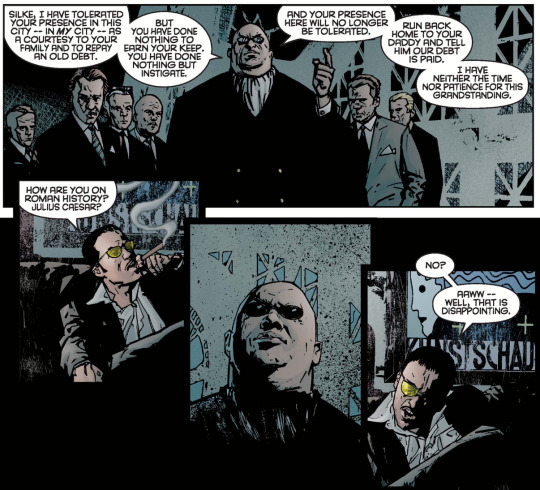
Yeah, Fisk, that’s what we call an indication to get the heck out of dodge. Oh well!

Yeah so Fisk gets stabbed a lot and dies. (Well. “Dies.”) Sorry, Fisk.
Meanwhile, what’s Matt up to?
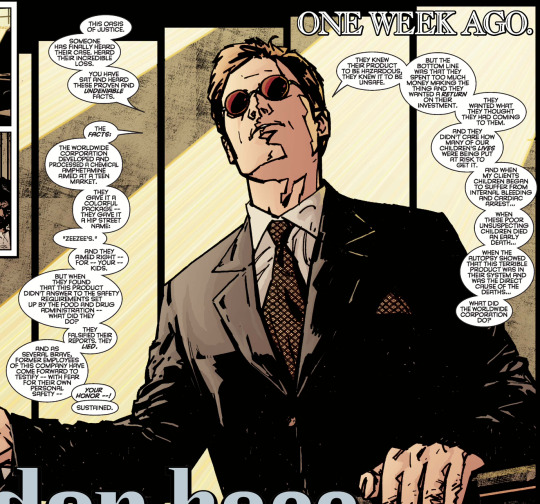
So this speech bubble thing...*sigh* This is a very Bendis thing, this “talking heads with tons of speech balloons” thing. I always feel like when I complain about too much text on a page, people are going to think I don’t like...reading words. And I do like reading words! I read so many books, you guys.
But comics are meant to be a marriage of pictures and words, and this is not that. The art is supposed to carry the story forward. This, meanwhile, is the equivalent of going to see a movie but getting a still photograph with a voiceover instead. Bendis does many things well, but this “stylistic quirk” of his always feels more like he’s refusing to edit down than anything else.
Anyway, Matt and Foggy win the case, it’s all great, everyone loves them, but the minute they step outside the courthouse and into a car:
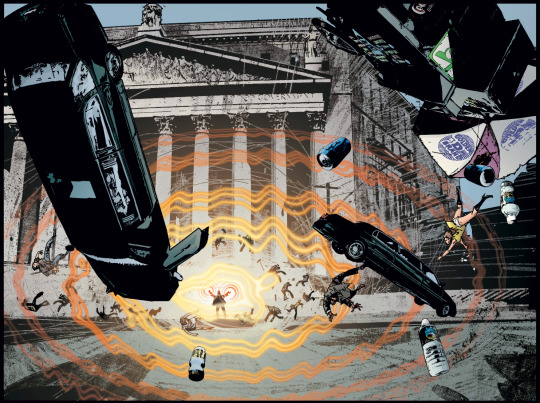
That guy at the center? He’s a meta. Luckily, our boys survive:
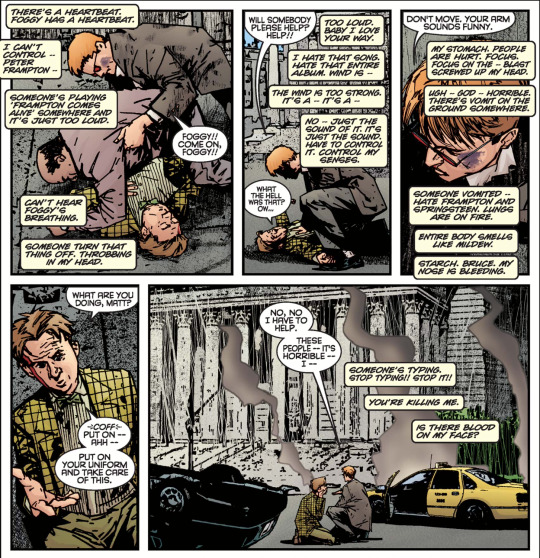
I love Matt frantically trying to get to Foggy and I love Foggy being like “I’m fine, go get ‘em, tiger.” Also because of this scene I always think of Daredevil when I hear “Baby I Love Your Way” and - this is a true story - one time I was sitting in a cafe and this song was playing and then the door opened and Charlie Cox walked in. Swear to God!
Matt suits up and tracks down the meta, but all he’ll say is that there’s a hit out on Matt Murdock. Unsure of what to do, Matt goes to visit Foggy at the hospital (TAKE SOME NOTES, MCU MATT), only to get bowled over by a visit from Foggy’s mom:

So I guess the Nelsons abruptly became Jewish for one issue? And Anna flew all the way from Ohio because her son broke his arm after visiting him all of twice in like the 15-20 years before that?
Anyway yeah Anna’s wildly out of character but I’m including this scene because a) I love Foggy’s irritated reaction which is very in keeping with the personality Bendis is honing for him, and b) Anna’s reaction here, and specifically her reaction to Matt, might offer some hints as to why we haven’t seen any of Foggy’s relatives since this 17-year-old comic.
So why is all of this happening? Let’s flash back to before the attack on Fisk, before the bombing, to when Sammy Silke first arrived in New York:
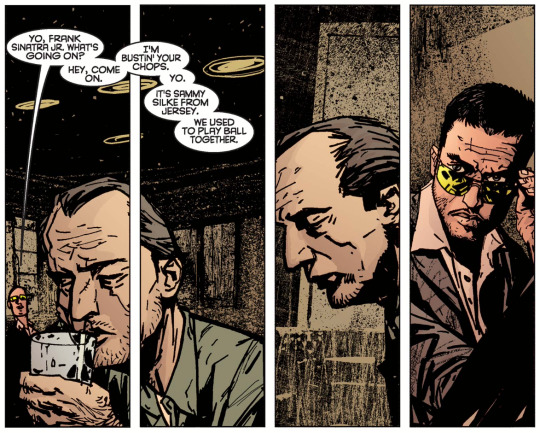
This is Fisk’s son Richard. Yes, SON. He hasn’t appeared in any Daredevil stories before, but he’s been in Spider-Man stuff as both villain and anti-hero, alternately called the Schemer, the Rose, and BLOOD ROSE, which I cannot get over, that is hilarious to me.
Anyway these days the life has clearly gone out of him and he barely responds to Sammy’s overtures. Huh.
Back to the present. Matt receives a hilarious explanatory note:
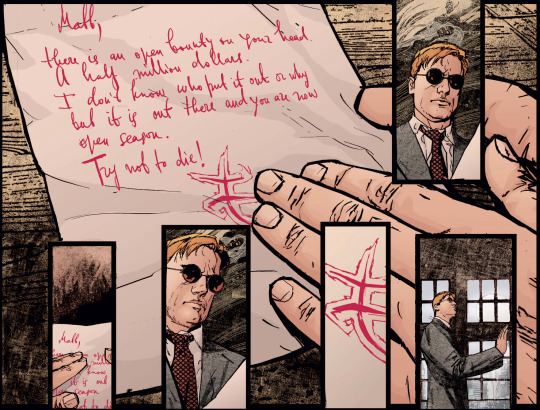
Oh, Elektra. You are fabulously unhelpful and I love you. Also signing your name like that is so extra I can’t even deal.
Back in the past, Silke asks Fisk for a favor. See, Silke’s dad wants an annoying lawyer offed:
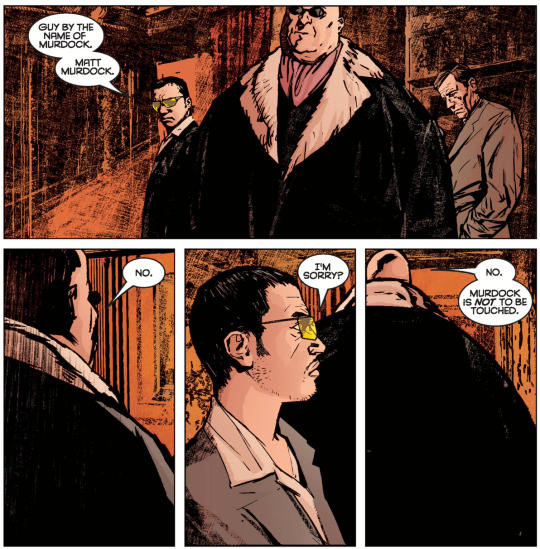
Now, as far as most people know, Matt’s a good lawyer, but there’s no reason that he should be under the Kingpin’s protection. So Silke gets curious.
Another time jump - now we’re after the bombing at the courthouse but before Fisk’s stabbing. Daredevil goes to the person most likely to put out a bounty on Matt Murdock:
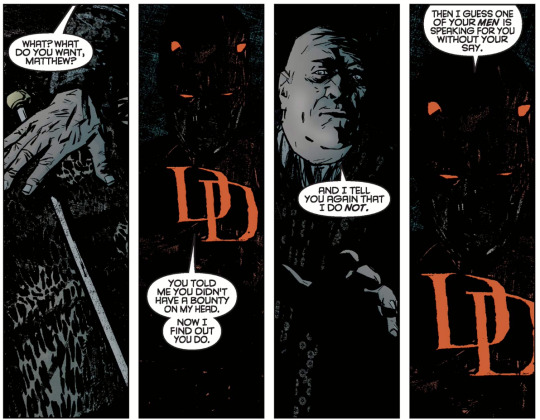
Fisk doesn’t always call Matt “Matthew” BUT HE SHOULD, it’s delightful. (Similarly, Matt should always call Fisk “Wilson,” or maybe “Willie” when he’s being sassy.) Anyway now Matt knows Fisk didn’t call the hit, and Fisk knows that there’s dissent within his organization.
Jump forward to after Fisk’s stabbing. He’s not actually dead, but he’s barely clinging to life. And one of the people still loyal to him called in Vanessa, who is estranged from him but also not at all pleased by this development. She flies in from Europe to handle things:
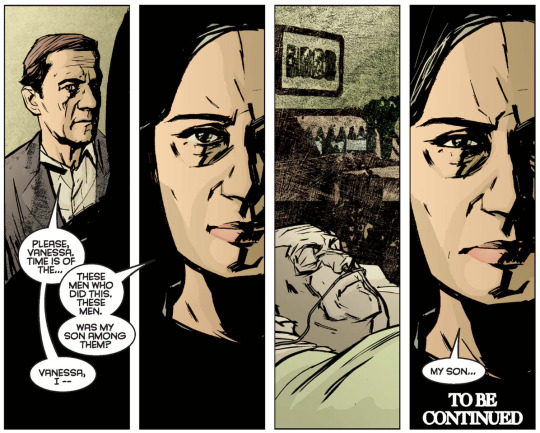
Well, that’s not good.
Pre-Fisk’s stabbing. Matt talks to Ben to see if he knows who might have put out the contract. Ben drags him all around the block:
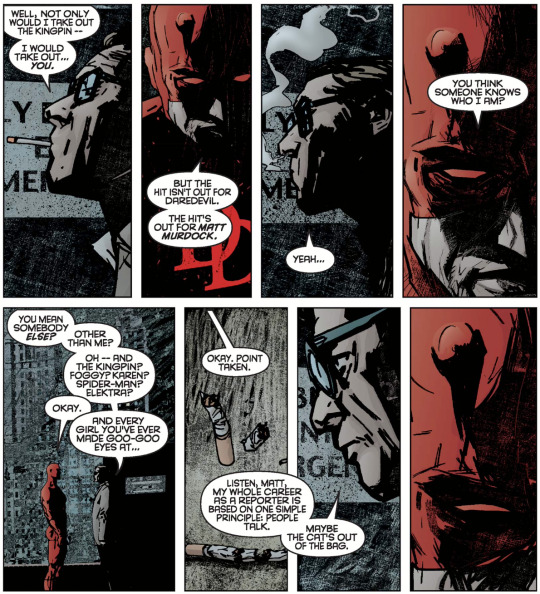
Hahaha oh Matt. You horny dumbo.
Two weeks ago. Richard Fisk tells Sammy Silke why Matt Murdock is off limits:
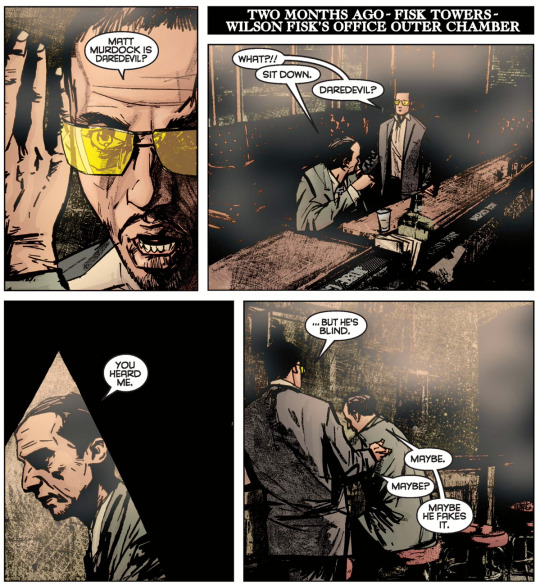
Yeah, so sometime between Born Again and now, someone figured out that Matt is Daredevil, and now pretty much everyone in Fisk’s inner circle knows. But they’re all good soldiers, so they pretend they don’t know, and Fisk doesn’t know they know.
Silke thinks that’s ridiculous, and a sign of the Kingpin’s weakness - his father would never let a known superhero live. So he and Richard decide to convince Fisk’s men to kill him so that they can take over. Richard doesn’t take much convincing:
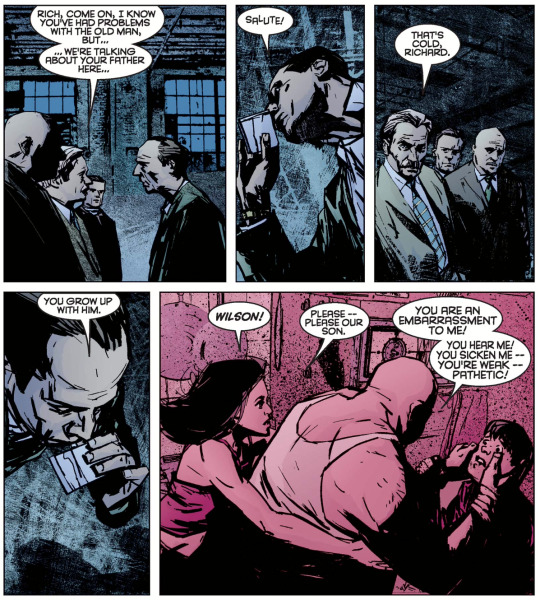
Flash forward to now. Vanessa may have tried to protect her son from Fisk’s abuse, but she is not about to forgive him for this:
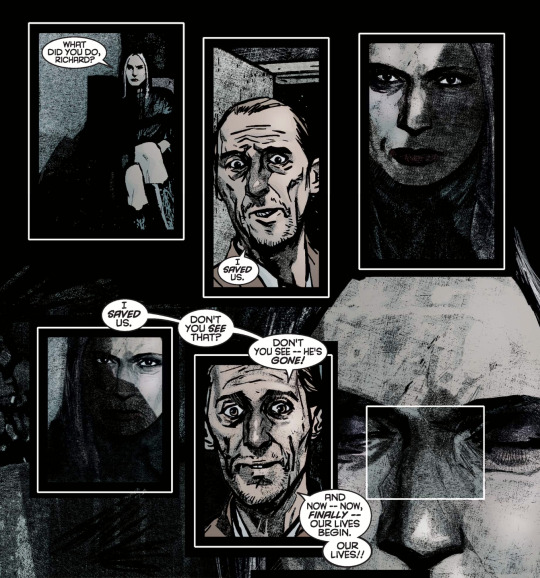
There is so little Vanessa in the comics, at least on the Daredevil side of things, and I wish I knew more, but I love how (when she’s not, um, a captive of sewer people) she always just exudes power.
Anyway, she makes a hard call:
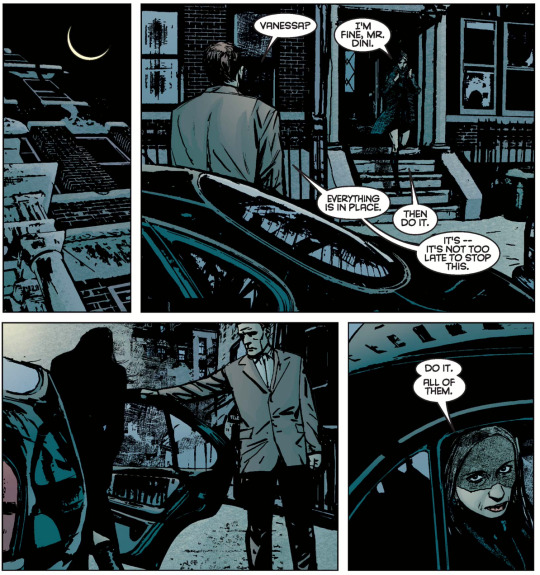
Bye, Richard! And everyone else involved in the hit!
As his co-conspirators start dropping like flies, Sammy Silke panics:

With no help coming from Papa Silke, Sammy makes a desperate decision and goes to the FBI:

Well, shit.
The FBI guys are basically like “Cool, we don’t care, you’re still going to jail,” but they do call in their boss to discuss this bombshell:

I want to cosplay as this guy. Just wander around a convention center biting my lip and holding up those two photos. It doesn’t even have to be during a comic con.
As the FBI digs into this allegation, they find increasingly weird stuff in Matt’s background: He has a SHIELD file. He dated a famous assassin who died in his arms. All of the financial stuff that went down during Born Again. It seems like this could be actually legit...
But the director still doesn’t want to act on it:
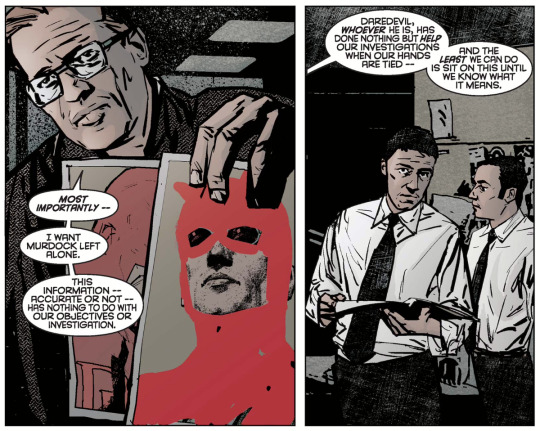
(Yes, one of them actually sat there and doodled a Daredevil costume over Matt’s face.)
So everything’s okay, right? Well, not exactly. See, FBI Guy #1 is pretty deep in debt, and he knows this information is worth something to someone...so he goes to a tabloid. And the next morning when Foggy stops at the newsstand:

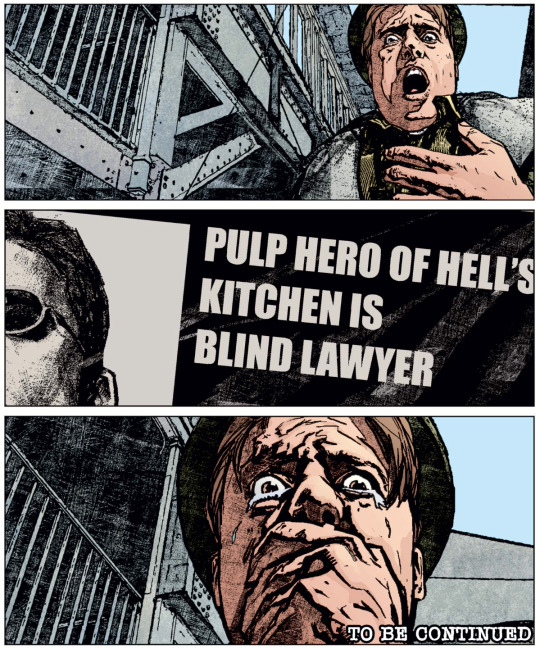
Next up: the fallout.
34 notes
·
View notes
Photo
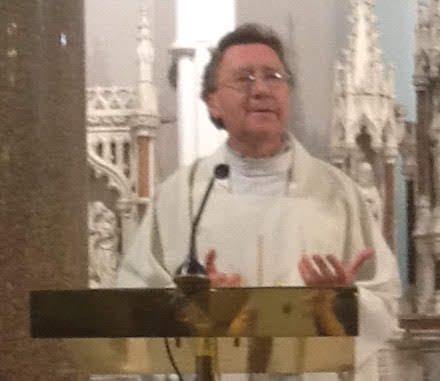
5th January >> Fr. Martin’s Gospel Reflections / Homilies on
John 1:1-18 for the Second Sunday after Christmas
or on
Matthew 2:1-12 for The Feast of The Epiphany of the Lord.
Second Sunday after Christmas
Gospel
John 1:1-18
The Word was made flesh, and lived among us
In the beginning was the Word:
and the Word was with God
and the Word was God.
He was with God in the beginning.
Through him all things came to be,
not one thing had its being but through him.
All that came to be had life in him
and that life was the light of men,
a light that shines in the dark,
a light that darkness could not overpower.
A man came, sent by God.
His name was John.
He came as a witness,
as a witness to speak for the light,
so that everyone might believe through him.
He was not the light,
only a witness to speak for the light.
The Word was the true light
that enlightens all men;
and he was coming into the world.
He was in the world
that had its being through him,
and the world did not know him.
He came to his own domain
and his own people did not accept him.
But to all who did accept him
he gave power to become children of God,
to all who believe in the name of him
who was born not out of human stock
or urge of the flesh
or will of man
but of God himself.
The Word was made flesh,
he lived among us,
and we saw his glory,
the glory that is his as the only Son of the Father,
full of grace and truth.
John appears as his witness. He proclaims:
‘This is the one of whom I said:
He who comes after me ranks before me
because he existed before me.’
Indeed, from his fullness we have, all of us, received –
yes, grace in return for grace,
since, though the Law was given through Moses,
grace and truth have come through Jesus Christ.
No one has ever seen God;
it is the only Son, who is nearest to the Father’s heart,
who has made him known.
Reflections (4)
(i) Second Sunday after Christmas
My sister’s parish church in Southern California is dedicated to a saint that many of us are not that familiar with, Saint Irenaeus. He was one of the great theologians of the church towards the end of the second century. He was born in ancient Smyrna, now Izmir in Western Turkey. He preached the gospel in Gaul and became bishop of Lyons, where he died. He once wrote, ‘the glory of God is the human person fully alive’. It is a statement that has always stayed with me.
I was put in mind of that statement of Saint Irenaeus by today’s gospel reading. It is the prologue to John’s gospel, that wonderful overture to the gospel as a whole, in the light of which we are invited to read this gospel. In that Prologue we find one of the most powerful statements in all of the New Testament, ‘the Word was made flesh, he lived among us, and we saw his glory, the glory that is his as the only Son of the Father, full of grace and truth’. The Word who is God became flesh in Jesus. God became human in the person of Jesus. We see the glory of God, the glorious presence of God, in Jesus, in a way that is true of no other human being and no other earthly reality. If we say with Saint Irenaeus that the glory of God is the human person fully alive, then we can say that Jesus is the human person most fully alive. As the Word made flesh, Jesus not only reveals God fully to us, but he also reveals what it is to be fully human. He shows us the face of God and he also shows us our own face at its best.
We firstly look to Jesus to show us the face of God. The end of the Prologue states that no one has ever seen God, except the Son who is nearest the Father’s heart. Regardless of the claims made by others, Jesus alone has seen God, and he alone can make God fully known to us. God has not revealed himself to us in lofty concepts, but in a human life, in the love-filled life of Jesus. Only Jesus has told us what God is like. Because of Jesus, we know how God regards us when we suffer. We know that God is with us in our suffering, as he was with Jesus on the cross. Because of Jesus, we know that God is a living God who can bring us beyond death into a greater fullness of life, just as he brought Jesus through death into new life. Because of Jesus, we know that God seeks us out when we are lost, just as Jesus spent his life seeking the lost and drawing them to himself. Because of Jesus, we know that God’s love is stronger than our sin and that God’s mercy knows no bounds for those who turn in him in poverty of spirit. Jesus is the true face of God, and whenever we turn away from Jesus, we risk distancing ourselves from the true God.
We also look to Jesus to show us our own true face as human beings. In Jesus we see what every human being is capable of becoming. In him we see our full potential as human beings, the human person fully alive. Jesus shows us what it means to live a fully human life. He not only reveals God to be Love but he also reveals that a truly human life is a loving life. Today’s second reading declares that God chose us in Christ ‘to be holy and spotless and to live through love in his presence’. Jesus was the one who, more than any other human being, lived through love in God’s presence. Everything he said and did was out of love for God and for humanity. He not only lived through love in God’s presence but he died through love in God’s presence. He showed us the kind of life and death we were created for. By taking him as our Way, by entering into his way of love, we will be fully alive and give glory to God. Saint Ephrem lived about two hundred years after Saint Irenaeus, in the fourth century in modern day Syria. Writing about eternal life said, ‘In the kingdom our departed ones achieve their full stature’. It is only when we see God who is Love face to face and become like God, as loving as God, that we will be fully alive in our humanity. However, insofar as we follow in the way of Jesus, in the way of loving service of God and each other, we will be growing towards that fully alive humanity which is our eternal destiny.
When the Word became flesh, God embraced our human nature and showed us how glorious our human nature can become. That gives us a profound respect for our own humanity and the humanity of others. God lived a human life in the person of Jesus and in doing so God ennobled every human life and powerfully proclaimed the dignity of every human person. Indeed, according to our gospel reading, God created all things through his Word. All of creation has been touched by God and is deserving of our care and respect.
And/Or
(ii) Second Sunday after Christmas
We have just begun a new year. There is something hopeful about the beginning of a new year. It is a time of new beginning. We let go of the old year and head out into the something new. Nature is also on the verge of a new beginning. Even though we are in mid winter, we know that each day is now that little bit longer than the previous one. With the lengthening of the daylight, there comes an emergence of new life. Although nature looks quite dead at the moment, we are aware that new life is beginning to stir. Soon the first snow drops and crocuses will begin to put their heads above the earth.
Today’s gospel reading reflects this moment of new beginning with its growing light. The gospel reading’s opening words are ‘in the beginning’. It then goes on to speak of a light that shines in the darkness, a light that darkness cannot overpower, a true light that enlightens everyone. The gospel reading, of course, is referring, not to the light of the sun, but to a different quality of light. It is the light of the Word who was with God in the beginning. Because this Word became flesh, became human, his light has become accessible to us. It is not a distant light, like a distant star, that can only be seen with a strong telescope. It is a light that envelopes all our living. The gospel reading is reminding us that we live and move in this special light. Later on in John’s gospel, Jesus says of himself: ‘I am the light of the world. Whoever follows me will never walk in darkness but will have the light of life’. Because Jesus is the Word made flesh, he identifies himself as this true light that shines in the darkness, and that the darkness cannot overpower.
I have always found that statement in today’s gospel reading to be one of the most hopeful statements in all of the New Testament: ‘A light shines in the darkness, a light that darkness could not overpower’. We are familiar with the overpowering presence of darkness in its various forms. A terrible darkness engulfed the people of South East Asia last Sunday morning, in the form of an earthquake and its tidal waves. We have all been appalled by the terrible loss of life. Most of us have known our own personal experiences of darkness. A darkness of spirit can engulf us; we can find ourselves getting depressed for some reason or other. A darkness of mind can also come over us; we find it hard to think clearly; we struggle to find a clear way forward out of some complex situation. We can find ourselves dealing with a darkness of heart, assailed by dark feelings that leave us feeling guilty and ashamed. Or we can be suddenly plunged into some dark and difficult situation that we had not anticipated. It might be an experience of bereavement or some other form of loss, a sudden onset of illness, in our own lives or in the life of a loved one, some major disappointment or an experience of personal failure. The dark experience, whatever form it takes, can threaten to overwhelm us. We might even find it hard to get out of bed in the morning and to face the day. The future seems uninviting.
It is to those kinds of situations that today’s gospel reading can speak most powerfully. ‘A light shines in the darkness, a light that darkness could not overpower’. In making that statement, the evangelist declares that there is no human darkness which the light of Christ cannot and does not penetrate. There is no human affliction that cannot be endured with the Lord’s help. St. Paul expressed that conviction very simply and powerfully in his letter to the Philippians when he said; ‘I can do all things through him who gives me strength’. There is a lot of talk today about resource people. Paul was very aware that the Lord was his primary resource. Today’s gospel reading assures us that the Lord is a resource to us all whenever we struggle with some dark experience. He is the true light that enlightens everyone. The Word became flesh and dwelt among us full of grace and truth, so that we might all receive from his fullness. The life-giving light of Christ shines on all our lives. Hopefully the people of South East Asia will continue to experience the light of Christ’s presence in and through the generosity of those men and women from so many nations who have responded to them in their hour of need.
The gospel reading acknowledges that people can turn away from this light. The true light was in the world and the world did not know him. A little later in John’s gospel the evangelist says: ‘The light has come into the world, and people loved darkness rather than light’. There remains the mystery of human freedom, the freedom to turn away from what is good, wholesome and life-giving. The Lord recognises that freedom. At one point in the gospel of John, he turns to his closest disciples and says to them: ‘Do you also wish to go away?’ Yet, that light of God that Jesus embodies continues to shine upon us and to invite us, even when we turn away from it. The presence of that light in our lives is not dependant on how well we receive it, just as the light of the sun does not grow weak when we try to shut it out. The Lord never turns away from us, and the light of his love never ceases to shine upon us. This is the good news we celebrate in the season of Christmas. It is what makes Christmas special.
And/Or
(iii) Second Sunday after Christmas
Yesterday was New Year’s Day. We are beginning a new year. It is traditionally a time when we try to take stock. We look back over the year that has gone, and we look forward to the year that is coming. The turning of the year is often a time to become a little bit more reflective about our lives. When we look back on the past year we might identify good things that happened for us that we would like to build on. We might also identify experiences that were not so positive for us and that we would like to learn from. We need moments when we can take stock, when we ask ourselves, ‘How have I been?’ ‘Where have I been?’ ‘How do I want to be?’ ‘Where do I want to be?’ Transition moments are good times to ask those questions. The turning of the year is a transition moment in all our lives. We are making a new beginning. A new year is opening up before us. Although we remain in a dark time of the year, the darkest night is now past and, imperceptibly, the days are getting longer. The gradual emergence of light from darkness calls out to us to go towards the light, as it were, to make a new beginning on our life journey, one that in some way or other involves a turning from darkness towards the light, from death towards life, from a less self-centred way of life towards a more generous one.
The call to make a new beginning can be heard against the backdrop of today’s gospel reading. The word ‘beginning’ is there in the opening line of the gospel reading, ‘In the beginning was the Word’. That primordial beginning was characterized by the presence of the Word, the Word who became flesh in the person of Jesus of Nazareth, and whom Thomas at the end of John’s gospel went on to address as ‘My Lord and my God’. The gospel reading suggests that all of our beginnings are characterized by the presence of the Word made flesh, the presence of ‘my Lord and my God’. Not only is it the case that ‘in the beginning was the Word’ but in all our beginnings is the Word. The Lord is with us as we make every new beginning, as we set out on a new journey, drawn by the emerging light. In that reading the Word is also spoken of as the light, the true light that enlightens all people. As we set out the Lord is with us as light in our darkness, as the one who calls us into a greater light. We all struggle with darkness in one shape or form. Saint Paul spoke about a thorn in his flesh. We all have something that can drag us down and leave us feeling less alive, more burdened. One of the reasons we make a new beginning can be the desire to deal with our thorn in the flesh in a more life-giving and wholesome way. The gospel reading encourages us to make our new beginning by turning towards the Word who is the true light and who is always turned towards us.
The Word is the true light because in and through him the light of God shines upon us, the light of God’s grace and God’s love. That is a light we desperately need; it is a light for which we long. That light of God which comes to us through the Word, through the Lord, is more powerful than any darkness we may be struggling with. The gospel reading speaks of that true light as a light that shines in the darkness and that darkness could not overpower. We are being assured that the darkness we struggle with, whatever form it takes, need never be the ultimate reality; it need never have the final say, the last word. The light of God’s grace, of God’s love, always has the last word, if we let it, because it is stronger than any darkness in which we might find ourselves. As we begin a new year, the gospel reading this morning reminds us that a great mystery lies beneath the surface of all our lives; it is the mystery of the Word made flesh who is present to us as the true light that shines in our darkness, even, and especially, in those experiences of darkness that threaten to overwhelm us.
The gospel reading calls on us to open our hearts and our lives to the light of the Word who became flesh, who has entered our human condition and is always to be found at the heart of our human experience. He is at the heart of our lives as one who is full of grace and truth, in the words of the gospel reading, full of God’s gracious and faithful love; he invites us to receive from his fullness, so that we can come to say, in the words of the believing community that stands behind this gospel reading, ‘from his fullness we have, all of us, received – yes, grace upon grace’. As we begins this new year we are being strongly reminded in the church’s liturgy of how greatly graced we are, and that is why we can keep setting out in hopeful faith, knowing that light shines in the darkness and the darkness cannot overpower it.
And/Or
(iv) Second Sunday after Christmas
One of the buildings inside the Vatican City is the Vatican Observatory. The director of the Observatory is often asked the question, ‘Why does the Vatican support an observatory?’ We get copies of the religious newspaper called the Tablet here in the parish. The other day I was looking at the Christmas edition of the Tablet and I read there the answer that the director of the Vatican Observatory gives to that question he is frequently asked. He said the reason the Vatican supports an observatory is very much linked to the feast of Christmas. At Christmas we celebrate the extraordinary news that God chose to become part of the created universe. This morning’s gospel reading puts it very simply and very profoundly, ‘The Word became flesh; he lived among us’. The Word who is God became human flesh, without ceasing to be God, in the person of Mary and Joseph’s child, Jesus of Nazareth. The director of the Vatican observatory says that in becoming part of the created universe, in become flesh, God shows us that this physical universe matters greatly. It matters so much that God chose to be part of it. The careful study of this universe, of God’s creation, which is what we call science, thereby becomes an act of worship. The director goes on to say that ‘astronomy is not only an appropriate activity for a church to support, it is also right for individual humans to spend their whole lives doing it, if given the chance’. The baby in the manger, he says, gives importance and meaning to all the physical activity of the universe.
The Word in becoming flesh teaches us to value the physical universe and the work of scientists who devote themselves to studying that universe. In becoming flesh, the Word did not simply become part of the physical universe. More specifically, the Word who is God became human, taking on a human nature. If our human nature was good enough for God to embrace, then we should highly value our human nature. We also value the efforts of all those who work to try and understand our human nature more fully, those who devote time and energy to understanding how our body works, how our mind functions, the role our emotions play in our lives, and the spiritual dimension of our human nature. The incarnation, the Word becoming flesh, gives an added significance to all those human sciences that seek to understand who we are. Just as the study of the planets and the physical universe can be an opening onto God, so the study of the human person in all his or her dimensions can also be an opening onto God, because Jesus has shown that human nature has the capacity to be a powerful revelation of God. The Word became flesh.
In becoming flesh, God is inviting us to become alert to the ways that the physical universe and, in particular, human nature, the human person, can be powerful revelations of God. Because God is Creator it is above all when we as humans are at our most creative that we can be revealing God most fully. All those involved in the creative arts have a wonderful opportunity to reveal God to us and to help bring us into an experience of God. Looking upon a painting of a great artist can be a very spiritual experience. If the artist is in some way open to the divine spirit then his or her work can drawn us into an experience of the divine. Some of the paintings of the artist Caravaggio come to mind. I can never look upon his depiction of the call of Matthew without feeling myself called in some way. Some creative artists work in stone or in other materials. Their work too can have a spiritual quality that allows us to be touched by God. Musicians are another example of creative artists who make it possible for us to sense the divine. A Swiss Protestant theologian, Karl Barth, once said: ‘When the angels sing for God, they sing Bach; but I am sure that when they sing for themselves, they sing Mozart – and God eavesdrops’. Many great artists of all kinds have been aware of themselves as channels for God’s energies. What is true of musicians and artists is equally true of poets and novelists, those who give expression to their creativity in word. Some verses of some of the poems that I learned in secondary school have stayed with me into adult life, and I believe it is because those poems had a spiritual quality to them. The poet was somehow open to divine inspiration.
Because of the incarnation, the Word becoming flesh, God can work powerfully in and through all of our lives. Our own flesh can be, and often is, a revelation of God. Saint John in his first letter wrote ‘God is Love’. When he writes the Word, who is God, became flesh, he is really saying, God’s love became flesh. As we go about our daily lives, whenever we give of ourselves in love to someone, God’s love continues to become flesh in us. Whenever we give without expecting a return, whenever we share our resources, our gifts, our time, our energy, so that others can live a fuller life, God’s love is becoming flesh in us.
---------------------------------------
The Epiphany of the Lord
Gospel (Europe, Africa, New Zealand, Australia & Canada)
Matthew 2:1-12
The visit of the Magi
After Jesus had been born at Bethlehem in Judaea during the reign of King Herod, some wise men came to Jerusalem from the east. ‘Where is the infant king of the Jews?’ they asked. ‘We saw his star as it rose and have come to do him homage.’ When King Herod heard this he was perturbed, and so was the whole of Jerusalem. He called together all the chief priests and the scribes of the people, and enquired of them where the Christ was to be born. ‘At Bethlehem in Judaea,’ they told him ‘for this is what the prophet wrote:
And you, Bethlehem, in the land of Judah,
you are by no means least among the leaders of Judah,
for out of you will come a leader
who will shepherd my people Israel.’
Then Herod summoned the wise men to see him privately. He asked them the exact date on which the star had appeared, and sent them on to Bethlehem. ‘Go and find out all about the child,’ he said ‘and when you have found him, let me know, so that I too may go and do him homage.’ Having listened to what the king had to say, they set out. And there in front of them was the star they had seen rising; it went forward, and halted over the place where the child was. The sight of the star filled them with delight, and going into the house they saw the child with his mother Mary, and falling to their knees they did him homage. Then, opening their treasures, they offered him gifts of gold and frankincense and myrrh. But they were warned in a dream not to go back to Herod, and returned to their own country by a different way.
Gospel (USA)
Matthew 2:1–12
We saw his star at its rising and have come to do him homage.
When Jesus was born in Bethlehem of Judea, in the days of King Herod, behold, magi from the east arrived in Jerusalem, saying, “Where is the newborn king of the Jews? We saw his star at its rising and have come to do him homage.” When King Herod heard this, he was greatly troubled, and all Jerusalem with him. Assembling all the chief priests and the scribes of the people, he inquired of them where the Christ was to be born. They said to him, “In Bethlehem of Judea, for thus it has been written through the prophet:
And you, Bethlehem, land of Judah,
are by no means least among the rulers of Judah;
since from you shall come a ruler,
who is to shepherd my people Israel. ”
Then Herod called the magi secretly and ascertained from them the time of the star’s appearance. He sent them to Bethlehem and said, “Go and search diligently for the child. When you have found him, bring me word, that I too may go and do him homage.” After their audience with the king they set out. And behold, the star that they had seen at its rising preceded them, until it came and stopped over the place where the child was. They were overjoyed at seeing the star, and on entering the house they saw the child with Mary his mother. They prostrated themselves and did him homage. Then they opened their treasures and offered him gifts of gold, frankincense, and myrrh. And having been warned in a dream not to return to Herod, they departed for their country by another way.
Reflections (4)
(i) Feast of the Epiphany
People tend to make more journeys over the Christmas period than they usually do. We set out on journeys to meet up with family members and friends and they set out on journeys to meet up with us. There can be an element of difficulty about any journey we make. The journeys of many people were particularly difficult in the days before Christmas because of the awful wintry weather we had. Listening to people who had been stranded at airports for hours and sometimes days made you realize that the journey to which they had been so looking forward had become something of a nightmare. Most of the journeys we make are, thankfully, much less troublesome than that, but any journey, other than the routine ones we might make around where we live, can have its challenges.
At the centre of today’s feast is the story of a journey. Matthew at the beginning of his gospel tells the story of a journey made by magi or astrologers from the East towards Judea in search of the new born king of the Jews. Matthew may have imagined these travellers as coming from a long way east because magi were originally associated with Persia. In Matthew’s account these magi were guided on their very long journey by a star which was different from all the other stars in the sky. There was something about this star which called them to set out on this long journey westwards. The most dangerous moment in their long journey came just as they were within striking distance of their destination. In Jerusalem, a short distance from Bethlehem, they were summoned by King Herod the Great, a man known to us from historical sources to have been very hostile towards anyone who might be a threat to his power, even, according to Matthew, a new born child whom some were recognizing as king of the Jews, the Jewish Messiah. Yet, in spite of that dangerous moment, the magi were led by the star to their destination, Bethlehem, where they worshipped the child and gave him their gifts. On their homeward journey, they were guided again, this time by means of a dream. In their dream God directed them to go home by a different route, and not via Jerusalem where they were likely to meet up with Herod again.
In some way, the story of these exotic visitors from the East is the story of each one of us. Our lives as Christians can be understood as a journey, a sacred journey, a pilgrimage. In fact, according to the Acts of the Apostles, from very early days Christians were known as followers of the Way. We are people who are following a way, and the way we are trying to follow is the way of Jesus, the way of the one who said of himself, ‘I am the Way, the Truth and the Life’. The magi were guided on their journey by a star which stood out from all the other stars in the sky. We too are guided on our journey by a light which stands out from all the other sources of light we come across. We are guided by the one who said of himself, ‘I am the light of the world. Whoever follows me will never walk in darkness’. On this earthly pilgrimage which we travel together, we don’t chart our own course. Rather, like the magi, we allow ourselves to be led. We submit to a light beyond us which is greater than any light within us. We look towards the one who has travelled the journey before us and who guides and leads us on our own journey. In the words of the letter to the Hebrews, using the image of the race rather than the journey, we ‘run with perseverance the race that is set before us, looking to Jesus the pioneer and perfecter of our faith’. Like the magi, we too meet with obstacles on our shared journey. Some version or other of a Herod can stand before us to deflect us from our journey. Jesus was very aware that even though he would be ever present to his followers as their light and their guide they would be tempted by evil under various guises. That is why he taught us to pray, ‘Lead us not into temptation, but deliver us from evil’. Yet in spite of Herod, the magi reached their destination and returned home safely. On our own journey too, as Saint Paul reminds, it is always the case that ‘where sin abounds, grace abounds all the more’. At the end of their journey, the magi worshipped the child; the giving of their gifts was but an outward expression of their worship, their homage. Our own journey too will end in worship, the worship of God and of his Son in heaven forever. Every act of worship on the way, in particular our Eucharistic worship, is an anticipation of that eternal worship before the throne of God and the Lamb. Our Eucharist worship overflows into our daily lives where it takes the form of the offering of ourselves to the Lord, the giving of the gift of our mind, our heart, our soul and strength in love to the Lord. This morning we look, in gratitude, towards the magi, these outsiders from far away, because they show us the fundamental shape of our lives as Christians.
And/Or
(ii) Feast of the Epiphany
The poet T.S. Eliot wrote a poem on the journey of the Magi. The concluding lines of the poem caught my attention.
This: were we led all that way for
Birth or Death? There was a Birth, certainly
We had evidence and no doubt. I had seen birth and death,
But had thought they were different; this Birth was
Hard and bitter agony for us, like Death, our death.
We returned to our places, these Kingdoms,
But no longer at ease here, in the old dispensation,
With an alien people clutching their gods.
I should be glad of another death.
Eliot imagines that the journey of the magi to witness the birth of Jesus was like a death for them. They were so touched by the mystery of this child that they experienced a need to die to what they had once valued. As Eliot says, they returned to their kingdoms but were no longer at ease there, in the old dispensation, with an alien people clutching their gods. The evangelist may be hinting at something similar when he states that after worshipping the child and giving him their gifts, the magi returned to their country by a different way. Their return journey was different to their original journey in search of the infant King of the Jews. Having encountered him, they were somehow different; they had been changed. The final line of the poem, ‘I should be glad of another death’ may be Eliot’s way of saying that, although he has been touched by the mystery of Emmanuel, God with us in the person of Jesus, he has not yet been fully grasped by this mystery, and he still has a death to undergo.
We might be able to think of encounters we have had in the course of our lives that touched us deeply, people that we met who impacted on us in some profound way, perhaps emotionally or intellectually. The mystery of the other can affect us at a very deep level and leave us changed. If other people reveal something of God’s presence, of God’s goodness and love, then our encounter with them will change us for the better, even though that change may be painful and involve a kind of a death, a dying to what is not of God. If that is true of an encounter with another human being, how much more true must it be of an encounter with the Lord who reveals God’s presence, God’s goodness and God’s love to a unique degree? The term ‘epiphany’ means a ‘revelation’, a disclosure’, a ‘shining forth’. Today’s feast celebrates the good news that in the child of Mary and Joseph, God’s goodness and love shone forth, was revealed to all of humanity, including those who came from afar, who would have been considered outsiders and strangers.
There is a great breadth and openness about this feast. The Lord is given to all, to all who seek the truth in sincerity of heart, to all who are prepared to keep setting out on a journey of discovery because they sense that there is a death they still need to undergo to become more fully alive. The great breadth and openness of this feast is shown in the way the tradition about the magi from the east developed and was embellished. They were understood to be three, corresponding to the three gifts; they were given names; Melchior represented the black skinned people, Balthasar, the Asians, and Gasper, the Europeans. Their great diversity signified the universal outreach of God through this child whose name was Emmanuel, God with us. This child may be known as King of the Jews, but he belongs to all.
The magi from the East went on a long and difficult journey in search of this child. Having found him, they submitted to the mystery of his otherness; they worshipped him and gave him their gifts. This child is now risen Lord. Today’s feast invites all of us to submit to the Lord, to give him, not any material gifts, but the gift of our hearts, minds and wills. This will inevitably involve a death of some kind, a dying to our various false gods, but it is a death that is ultimately life-giving, because in surrendering to the Lord we will receive from his fullness, grace upon grace. An Epiphany, a revelation of God, calls for a humble response, a journeying out of ourselves towards a great light and a fuller truth.
The figure of Herod in today’s gospel reading shows us a very different kind of response to the presence of an epiphany. When a new and fuller light appeared, Herod sought to extinguish it. Rather than hear the call of Emmanuel to die to his false gods, he was determined to inflict death on this Epiphany. To some degree, we are all capable of extinguishing the light of God’s goodness, present in the lives of others. Today’s feast invites us to align ourselves with the magi in their desire to journey towards Emmauel, God with us, and in their openness to being changed by that encounter. It is in the Eucharist that we encounter Emmanuel is a special way. The Eucharist is our weekly, our daily, Epiphany. The Eucharist is the moment when we surrender to the Lord, with whatever dying that might require of us, so that we can receive from his fullness.
And/Or
(iii) Feast of the Epiphany
The poet T.S. Eliot wrote a poem on the journey of the Magi. The concluding lines of the poem are thought-provoking:
This: were we led all that way for
Birth or Death? There was a Birth, certainly
We had evidence and no doubt. I had seen birth and death,
But had thought they were different; this Birth was
Hard and bitter agony for us, like Death, our death.
We returned to our places, these Kingdoms,
But no longer at ease here, in the old dispensation,
With an alien people clutching their gods.
I should be glad of another death.
Eliot imagines that the journey of the magi to witness the birth of Jesus was like a death for them. They were so touched by the mystery of this child that they experienced a need to die to what they had once valued. As Eliot says, they returned to their kingdoms but were no longer at ease there, in the old dispensation, with an alien people clutching their gods. The evangelist may be hinting at something similar when he states that after worshipping the child and giving him their gifts, the magi returned to their country by a different way. Their return journey was different to their original journey in search of the infant King of the Jews. Having encountered him, they were somehow different; they had been changed. The final line of the poem, ‘I should be glad of another death’ may be Eliot’s way of saying that, although he has been touched by the mystery of Emmanuel, God with us in the person of Jesus, he has not yet been fully grasped by this mystery, and he still has a death to undergo.
Today’s feast celebrates the good news that in the child of Mary and Joseph, God’s goodness and love shone forth, was revealed to all of humanity, including those who came from afar, who would have been considered outsiders and strangers. There is a great breadth and openness about this feast. The Lord is given to all, to all who seek the truth in sincerity of heart, to all who are prepared to keep setting out on a journey of discovery because they sense that there is a death they still need to undergo to become more fully alive. Today’s feast invites all of us to submit to the Lord, to give him, not any material gifts, but the gift of our hearts, minds and wills. This will inevitably involve a death of some kind, a dying to our various false gods, but it is a death that is ultimately life-giving, because in surrendering to the Lord we will receive from his fullness, grace upon grace. An Epiphany, a revelation of God, calls for a humble response, a journeying out of ourselves towards a greater light and a fuller truth.
And/Or
(iv) Feast of the Epiphany
On this feast of the Epiphany our crib scene is complete, with the arrival of the three visitors from the East. Tradition has made kings of these visitors, but the gospel passage which is the basis of this tradition speaks of magi. In that culture, magi were people with a certain set of skills, people possessed of some kind of specialized knowledge. The gospel passage suggests that the specialized knowledge of these magi related to the interpretation of the stars. They were not kings themselves but served the king with their skills. The gospel passage does not say how many of them there were. The number three was simply deduced from the number of gifts that were brought. The evangelist Matthew says they came from the east, without specifying from where. Magi were often associated with Persia, in particular, which corresponds to modern day Iran. They were clearly intended by the evangelist as representatives of the non-Jewish world. Their observation of the rising of a new star led them to believe that a new king of the Jews has been born. There was a widespread belief in that world that the birth of new leaders was marked by unusual events in the heavens. The natural gifts and acquired knowledge of these magi set them on a journey towards the child of Mary and Joseph whose name was Emmanuel, God with us. Their science was not in any way in conflict with their religious search. Rather, their study of the stars was the inspiration for their long journey towards a place of worship, ‘We saw his star as it rose and have come to do him homage’. Science is never in conflict with faith. Both are different and complementary paths to God. The story of the magi suggests that the study of creation, whether it is the heavenly world or some other dimension of creation, can serve the journey of faith, and help to bring us to the worship of the God who stands behind all created reality and who has become God with us in the child of Bethlehem.
In the story we have just heard, the journey of the magi from the East did not bring them to Bethlehem initially. It brought them to the principal city of Judea, Jerusalem, some miles north of Bethlehem. When they reached Jerusalem, they asked, ‘Where is the infant king of the Jews?’ Their expertise in reading the heavens did not make them think that they knew it all. The evangelist portrays these specialists as humble people. They did not have all the answers. They remained people who questioned. They knew they needed the help of others who had a different expertise to theirown if their question ‘Where?’ was to be answered. In the gospel reading it is the chief priests and the scribes, those who had studied the Jewish Scriptures, who provided the information that allowed them to complete the last short leg of their journey. According to the prophet Micah, the shepherd king whom God will provide for his people will come from Bethlehem, the birthplace of King David. The magi’s observation and interpretation of the skies brought them a long way on their journey towards God with us. However, they needed the Jewish Scriptures to complete the journey. Creation is a revelation of God the Creator, but the Scriptures are a fuller revelation of God. These pagan specialists from the east were open to both expressions of God’s revelation. They were receptive to the various ways that God can speak to us. We can learn from them to be attentive to God’s word, whatever form that word may take. There are times in our lives when God seems to speak most powerfully to us through the wonders and beauty of creation. There are other times when we feel the need to listen attentively to the Lord’s word as it comes to us in both the Jewish and Christian Scriptures. The magi speak to the seeker within each one of us, that deep core whose longing cannot be fully satisfied by anything in this earthly life. Genuine seekers are always open to the many and varied ways that God communicates with us and seeks us out.
The long journey of the magi was finally crowned with an act of worship and an act of generosity, ‘they did him homage… they offered him gifts’. They surrendered themselves and their possessions to the Lord. We believe that our own life journey will be crowned in the same way. At the end of our lives, we surrender ourselves, all we are and have, into the hands of the living and loving Lord. Our own times of worship in the course of our life journey, our own acts of self-giving to the Lord, anticipate and prepare us for that final moment of self-surrender. One element of this inspiring story is theominous presence of Herod. He too asked the question where the Christ was to be born. However, his motive in asking this question was very different to that of the magi. He wanted to eliminate a perceived threat to his throne. On our faith journey there will often be forces that are hostile to God’s purpose for our lives. Yet, this assures that, in the words of the fourth gospel, ‘the light shines in the darkness, and the darkness did not overcome it’.
Fr. Martin Hogan, Saint John the Baptist Parish, Clontarf, Dublin, D03 AO62, Ireland.
Email: [email protected] or [email protected]
Parish Website: www.stjohnsclontarf.ie Please join us via our webcam.
Twitter: @SJtBClontarfRC.
Facebook: St John the Baptist RC Parish, Clontarf.
Tumblr: Saint John the Baptist Parish, Clontarf, Dublin.
0 notes
Text
Review: ‘Eurydice,’ a New Opera, Looks Back All Too Tamely
LOS ANGELES — The composer Matthew Aucoin began working on “Crossing,” his first opera, when he was in college. It was a work of enormous talent, exciting promise and considerable hubris: Mr. Aucoin wrote his own libretto, inventing a story about Walt Whitman’s work with wounded soldiers during the Civil War.
If “Crossing” (2015) lacked “a certain kind of unity” — as Mr. Aucoin, now 29, said in a recent interview — it was still taut, intense and audacious. What would he do next?
The answer came on Saturday, with the premiere of “Eurydice” at Los Angeles Opera, where it runs through Feb. 23 before traveling to the Metropolitan Opera next year. This project demanded a very different approach. Mr. Aucoin didn’t write the libretto; instead, the text was a collaboration with the playwright Sarah Ruhl, closely hewing to her 2003 play, a modern-day take on the Orpheus and Eurydice myth which tells the story from the woman’s perspective.
The play is meditative and surreal, fantastical and funny. Mr. Aucoin said in the interview that he thought he needed to do remarkably little: He wanted just to “tap” the words, to release the wells of emotional undercurrents in Ms. Ruhl’s clean, simple phrases. Throughout this three-act opera, you sense Mr. Aucoin honorably striving to serve the play.
He may have been overly deferential. Ms. Ruhl’s libretto called for a lighter, more enchanting score than “Crossing.” But the musical language of “Eurydice” is at times curiously tame.
I liked the opera most when, during fraught episodes, the music turns jagged and dangerous. Whenever Mr. Aucoin gives vent to his liveliest voice — with hints here of Ravel, Britten and Thomas Adès — the opera takes off.
I sat up every time he seemed to push the libretto aside briefly to let some gnarly, skittish music take charge, especially in the incisive performance he conducted. And the director Mary Zimmerman’s inventive production conveys the right mix of whimsical fairy tale and disturbing morality play through a simple, colorful staging, with sets by Daniel Ostling and costumes by Ana Kuzmanic.
After a short, quizzical overture, we meet Orpheus and Eurydice, dressed for fun at the beach. The vivacious Eurydice (the soprano Danielle de Niese) seems smitten with the hearty Orpheus (the baritone Joshua Hopkins). Yet you soon sense her doubts. A self-absorbed — if supernaturally talented — musician, Orpheus doesn’t share her passion for books and words. When he looks distracted and Eurydice asks him what he’s thinking about, he answers: “Music.”
In the opera’s boldest stroke, Mr. Aucoin, who sees Orpheus as a divided character, gives him a double. Orpheus the everyday guy — clueless if also endearing — is sung by Mr. Hopkins, with firm voice and youthful swagger. But Orpheus also has a godlike dimension, represented here by a countertenor, John Holiday, who appears in moments when Orpheus’s questing nature comes out. Eurydice doesn’t see Orpheus’s double, but panicky outbursts in the orchestra and her sputtered vocal lines suggest that she senses him.
Eurydice readily accepts Orpheus’s marriage proposal. But soon after, in the underworld, we see her deceased father, a sad, reflective man who still adores his daughter. (He is sung by the mellow-voiced baritone Rod Gilfry — an old Aucoin hand, having originated the role of Whitman in “Crossing.”)
He writes a letter to Eurydice, offering the fatherly advice he would have shared at the ceremony. Mr. Aucoin shows respect for the tender, charming words by setting them to somber music of lyrical pining over restless orchestral stirrings. But I wanted less reverence, and more intensity.
The wedding scene is wonderful, with guests dancing to gyrating music; at one point the orchestra becomes a riot of squiggly riffs. But Eurydice is somehow dissatisfied. “I always thought there would be more interesting people at my wedding,” she says.
Well, an interesting person appears: Hades, a character Mr. Aucoin clearly relished, written for high-lying tenor and sung fearlessly by Barry Banks. The god of the underworld, Hades first seems courtly, snaring Eurydice by telling her he has a letter for her from her father. Mr. Aucoin has a penchant for using the orchestra to hug vocal lines. He takes this to arresting extremes with Hades: Groups of instruments buttress, enclose, mimic and sometimes needle every syllable.
Ms. de Niese, though strained at times, sang with fullness and richly expressive shadings. She was riveting — a young woman tortured with indecision — as she went off with Hades then tumbled into the underworld.
The darkest element of the play and opera is how the underworld is depicted: The dead pass through a river of forgetfulness, where they lose their memories, and even language. Eurydice’s father has secretly kept possession of a pen — forbidden below — and his English. In a heartbreaking moment, the dead Eurydice arrives, holding an umbrella that has not protected her from the waters. She mistakes her beloved father for a porter.
Almost every musical telling of this myth has a moment when Orpheus sings a song that so enchants the gatekeepers of the underworld that he is given permission to enter and reclaim his wife. Mr. Aucoin’s version, with Orpheus joined by his double, is more a stentorian demand that an aria of lyrical persuasion. I thought the music, for all its stern fortitude, needed more threatening fervor.
The emotions of the characters are poked at throughout by a trio of bizarre figures: Little Stone (Stacey Tappan), Big Stone (Raehann Bryce-Davis) and Loud Stone (Kevin Ray). Like an irreverent Greek chorus, they laugh at human pretensions and encourage people to feel nothing. (No one gets hurt that way.) As they trade phrases and boisterously overlap, Mr. Aucoin’s music for them is aptly snide and harmonically slippery.
A chorus of nearly 40 voices provides harmonic plushness and ethereal sounds during crucial episodes. But Ms. Zimmerman, with the blessing of Mr. Aucoin, keeps the chorus backstage in an effort to focus on the main characters. This seemed a major miscalculation. The choral writing added pungency to the score. And the drama, which sometimes felt static, could have benefited from the presence of witnesses onstage. Ms. Zimmerman might reconsider this before the production travels to the Met, which co-commissioned the work.
When Orpheus is poised to lead his wife up to earth’s surface — agreeing not to look back as he does so — this Eurydice, her memory still fuzzy, is uncertain. Her husband is waiting, the three stones tell her. “That’s a stranger,” she answers: And when you think about it, wasn’t Orpheus, wrapped in his art, always a kind of stranger to this thoughtful woman?
After she has died a second time, Eurydice writes a sisterly letter to Orpheus’s future wife, giving Ms. de Niese a poignantly fragile final aria. Mr. Aucoin’s music lifts her vocal lines while shimmering tremulously in the background. Here this still-young, extravagantly gifted composer grabbed the dramatic moment and met it with energy and originality. If only he had done so more often.
Eurydice
Through Feb. 23 at the Dorothy Chandler Pavilion, Los Angeles; laopera.org.
from WordPress https://mastcomm.com/review-eurydice-a-new-opera-looks-back-all-too-tamely/
0 notes
Text
‘Mame,’ ‘Hello, Dolly!’ composer Jerry Herman dies at 88
https://newsource-embed-prd.ns.cnn.com/videos/newsource-video-embed.js
MIAMI — Tony Award-winning composer Jerry Herman, who wrote the cheerful, good-natured music and lyrics for such classic shows as “Mame,” “Hello, Dolly!” and “La Cage aux Folles,” died Thursday. He was 88.
His goddaughter Jane Dorian confirmed his death to The Associated Press early Friday. He died of pulmonary complications in Miami, where he had been living with his partner, real estate broker Terry Marler.
The creator of 10 Broadway shows and contributor to several more, Herman won two Tony Awards for best musical: “Hello, Dolly!” in 1964 and “La Cage aux Folles” in 1983. He also won two Grammys — for the “Mame” cast album and “Hello, Dolly!” as song of the year — and was a Kennedy Center honoree. He had three original Broadway productions playing at the same time from February 1969 to May 1969.
Tributes poured in Friday from Broadway royalty, including from Harvey Fierstein, who wrote the book of “La Cage aux Folles” alongside Herman’s songs. “We lost one of the greats,” Fierstein tweeted. “A collaborator and friend for almost 40 years. I cannot thank him enough for his love, trust, encouragement, support and laughter.” Writer and host Seth Rudetsky honored Herman for writing “quintessential Broadway songs. Beautiful melodies and fantastic lyrics.”
Herman wrote in the Rodgers and Hammerstein tradition, an optimistic composer at a time when others in his profession were exploring darker feelings and material. Just a few of his song titles revealed his depth of hope: “I’ll Be Here Tomorrow,” “The Best of Times,” “Tap Your Troubles Away,” “It’s Today,” “We Need a Little Christmas” and “Before the Parade Passes By.” Even the title song to “Hello, Dolly!” is an advertisement to enjoy life.
Herman also had a direct, simple sense of melody and his lyrics had a natural, unforced quality. Over the years, he told the AP in 1995, “critics have sort of tossed me off as the popular and not the cerebral writer, and that was fine with me. That was exactly what I aimed at.”
In accepting the Tony in 1984 for “La Cage Aux Folles,” Herman said, “This award forever shatters a myth about the musical theater. There’s been a rumor around for a couple of years that the simple, hummable show tune was no longer welcome on Broadway. Well, it’s alive and well at the Palace” Theatre.
Some saw that phrase — “the simple, hummable show tune” — as a subtle dig at Stephen Sondheim, known for challenging and complex songs and whose “Sunday in the Park with George” Herman had just bested. But Herman rejected any tension between the two musical theater giants.
“Only a small group of ‘showbiz gossips’ have constantly tried to create a feud between Mr. Sondheim and myself. I am as much of a Sondheim fan as you and everybody else in the world, and I believe that my comments upon winning the Tony for ‘La Cage’ clearly came from my delight with the show business community’s endorsement of the simple melodic showtune which had been criticized by a few hard-nosed critics as being old fashioned,” he said in a 2004 Q&A session with readers of Broadway.com.
Playwright Paul Rudnick on Friday praised Herman for providing “such joy.” And director and choreographer Matthew Bourne said Herman’s “feel-good shows full of melody and joy will live forever.” Bernadette Peters Elaine Paige and Carolee Carmello also mourned his passing.
Herman was born in New York in 1931 and raised in Jersey City. His parents ran a children’s summer camp in the Catskills and he taught himself the piano. He noted that when he was born, his mother had a view of Broadway’s Winter Garden Theatre marquee from her hospital bed.
Herman dated his intention to write musicals to the time his parents took him to “Annie Get Your Gun” and he went home and played five of Irving Berlin’s songs on the piano.
“I thought what a gift this man has given a stranger. I wanted to give that gift to other people. That was my great inspiration, that night,” he told The Associated Press in 1996.
After graduating from the University of Miami, Herman headed back to New York, writing and playing piano in a jazz club. He made his Broadway debut in 1960 contributing songs to the review “From A to Z” — alongside material by Fred Ebb and Woody Allen — and the next year tackled the entire score to a musical about the founding of the state of Israel, “Milk and Honey.” It earned him his first Tony nomination.
“Hello, Dolly!” starring Carol Channing opened in 1964 and ran for 2,844 performances, becoming Broadway’s longest-running musical at the time. It won 10 Tonys and has been revived many times, most recently in 2017 with Bette Midler in the title role, a 19th-century widowed matchmaker who learns to live again.
“Mame” followed in 1966, starring Angela Lansbury, and went on to run for over 1,500 performances. She handed him his Special Tony Award for Lifetime Achievement in 2009, saying he created songs like him: “bouncy, buoyant and optimistic.”
In 1983 he had another hit with “La Cage aux Folles,” a sweetly radical musical of its age, decades before the fight for marriage equality. It was a lavish adaptation of the successful French film about two gay men who own a splashy, drag nightclub on the Riviera. It contained the gay anthem “I Am What I Am” and ran for some 1,760 performances. Three of his shows, “Dear World,” “The Grand Tour” and “Mack and Mabel,” failed on Broadway.
Many of his songs have outlasted their vehicles: British ice skaters Torvill and Dean used the overture from “Mack and Mabel” to accompany a gold medal-winning routine in 1982. Writer-director Andrew Stanton used the Herman tunes “Put on Your Sunday Clothes” and “It Only Takes a Moment” to express the psyche of a love-starved, trash-compacting robot in the film “WALL-E.”
Later in life, Herman composed a song for “Barney’s Great Adventure,” contributed the score for the 1996 made-for-TV movie “Mrs. Santa Claus” — earning Herman an Emmy nomination — and wrote his autobiography, “Showtune,” published by Donald I. Fine.
“There has been no other music which took our breath away, that made us hum and cheer and respect ourselves more than a majestic Jerry Herman musical,” said Dorian.
He is survived by his partner, Marler, and his goddaughters — Dorian and Dorian’s own daughter, Sarah Haspel. Dorian said plans for a memorial service are still in the works for the man whose songs she said “are always on our lips and in our hearts.”
from FOX 4 Kansas City WDAF-TV | News, Weather, Sports https://fox4kc.com/2019/12/27/mame-hello-dolly-composer-jerry-herman-dies-at-88/
from Kansas City Happenings https://kansascityhappenings.wordpress.com/2019/12/27/mame-hello-dolly-composer-jerry-herman-dies-at-88/
0 notes
Text
Commodore Matthew Perry retires after decades of service - the New York Times
A copy of the New York Times, a new American newspaper circulating within the United States has been obtained by Japanese foreign intelligence on Tchoka Island.
Commodore Matthew Perry, best known for his failed bluff to open up the Tokugawa Shogunate which was likely seen through by the Shogunate as a bluff, has retired in April 1859, as his distinguished military career has ended with his retirement. The Commodore described his biggest regret as “not opening the poverty-stricken, rebelling region of Tokugawa Japan”, and said that “the freedom-seeking citizens of the Tokugawa Shogunate already are, and will, overthrow their masters soon”.
The Tokugawa Shogunate, a continuing enigma, reportedly purely ignored overtures by the Commodore to negotiate after the Commodore and his staff attempted to rectify certain terms which prohibited free trade and limited resource extraction heavily. The Shogunate, cut off from a world that has continued to evolve, has fallen behind its neighbors heavily technologically, with the Russian Empire basically having eliminated Japanese presence on Sakhalin Island after the islanders of Japanese origin mysteriously died, all of them having drawn blue spots on their neck.
0 notes
Text
Les XX and Guillaume Lekeu (Belgian, 1870–1894) and inspiration for the Vinteuil Sonata, an imaginary work described by Marcel Proust in In Search of Lost Time
#LesXX and Guillaume Lekeu (Belgian, 1870–1894) and inspiration for the Vinteuil Sonata, an imaginary work described by Marcel Proust in In Search of Lost Time
https://www.facebook.com/juhyung.han.5/posts/1718933688165798
http://blog.naver.com/artnouveau19/221222114385
Jean Joseph Nicolas Guillaume Lekeu (20 January 1870 – 21 January 1894) was a Belgian composer of classical music.
Life[edit]
Lekeu was born in Heusy, a village near Verviers, Belgium.[1] He originally studied piano and music theory under Alphonse Voss, the director of the brass band at the local conservatory. In 1879, his parents moved to Poitiers, France.[1] He continued to pursue his music studies independently while at school, composing his first piece at the age of 15.[1] From 1885 onwards, he regularly composed new music,[2] especially for piano, and studied harmony and violin from 1887 under Octave Grisard.
In June 1888, his family moved to Paris where he began to study philosophy.[3] He was introduced to the works of Téodor de Wyzewa and continued his studies under Gaston Vallin. In August 1889, he traveled to Bayreuth to see the operas of Richard Wagner. On his return, he studied counterpoint and fugue privately with César Franck.[2] Franck encouraged him to continue composing; after Franck's death in the autumn of 1890, Wyzewa introduced him to Vincent d'Indy, who taught him orchestration and encouraged him to compete for the Prix de Rome, awarded in Brussels.[1] In 1891, he won second prize in the competition for the cantata Andromède.[2]
In 1892, d'Indy introduced Lekeu to Octave Maus, then secretary of Brussels-based Le Cercle des XX.[2] Eugène Ysaÿe commissioned a work from him,[1] the Violin Sonata in G major, which premiered in March 1893, and is "his most famous and oft-recorded work".[4]
Lekeu contracted typhoid fever from a contaminated sorbet in October 1893.[5] He died in his parents' home in Angers on 21 January 1894, the day after his 24th birthday. On 26 January 1894, he was buried in a small cemetery in Heusy.[3]
Musical style and influences[edit]
Lekeu's personal style was present in his earliest compositions. In 1887, he said "Bien plus, ce sera bizarre, détraqué, horrible, tout ce qu'on voudra; mais, du moins, ce sera original"[5] ("Even more, it will be weird, mad, horrible, anything you like, but at least it will be original").
Lekeu's string quartets were inspired by Beethoven, and exposure to Wagner's operas at Bayreuth influenced his approaches to melody. He described this as "des mélodies de telle longueur qu'un seul exposé suffisait à parfaire ... un morceau de musique"[5] ("melodies of such length that a single presentation was sufficient to complete ... a piece of music").
His primary influence was Franck. Many of his works are characterized by a certain melancholy: in his own words, "la joie [est] mille fois plus difficile à peindre que la souffrance"[5] ("joy is a thousand times harder to paint than suffering").
Compositions[edit]
Lekeu composed about 50 works, and left a number of unfinished compositions at the time of his death. Two of these, a Cello Sonata and his Piano Quartet, were completed by D'Indy.[6] All have been recorded at least once, and several of them more than once, notably the Violin Sonata in G Major and the Piano Trio in C minor. The first time Piano Sonata in G minor had been completely performed on live by pianist Paweł Albiński in Kraków, Poland on 20 August 2014.[7]
His style, prophetic of early-twentieth-century avant-garde French composers like Satie and Milhaud, was influenced by Franck, Wagner and (especially in the Trio) Beethoven, though these influences did not manifest themselves as mere imitation. In general, Lekeu is regarded as a highly talented composer whose death cut short a promising musical career.
Musical structures[edit]
His larger compositions are cyclic in structure; that is, themes in his works will often recur from movement to movement, something no doubt inherited from a long tradition of nineteenth-century European composers, as well as from many works of Franck and d'Indy. The recurring themes in the violin sonata have led some scholars to suggest that it was an inspiration for the Vinteuil Sonata, an imaginary work described by Marcel Proust in In Search of Lost Time. However, the structure imagined by Proust is also similar to the violin sonata by Franck.[8]
https://en.wikipedia.org/wiki/Guillaume_Lekeu
Guillaume Lekeu (Belgian, 1870–1894) - Première Étude symphonique (1889-90)
https://youtu.be/nkGDpy4JgZo
Guillaume Lekeu (Belgian, 1870–1894) Larghetto pour violoncelle et orchestre 1892
https://youtu.be/ECN54VS6tNw
Guillaume Lekeu (Belgian, 1870–1894): Sur une tombe - Jaroussky
https://youtu.be/yxQd5Jrgd4k
Guillaume Lekeu (Belgian, 1870–1894) - Sonata for Violin and Piano in G Major - "Tres Lent”
https://youtu.be/wxvc84qb3zc
Guillaume Lekeu (Belgian, 1870–1894) - Sonata for Violin and Piano in G Major - "Tres anime”.
https://youtu.be/6fkZ0X9y0AQ
Guillaume Lekeu (Belgian, 1870–1894) - Fantaisie contrapuntique sur un cramignon liégeois (1890)
https://youtu.be/Q0Fyvm9BQoE
Guillaume Lekeu (Belgian, 1870–1894) Quatuor avec piano
https://youtu.be/OxaCXon74LM
Guillaume Lekeu (Belgian, 1870–1894) : Meditation for String Quartet
https://youtu.be/UBCgsue02iY
Nardo di cione, "final judgment", detail. Strozzi Chapel of Mantua (1350-57)
https://www.facebook.com/santamarianovella/photos/a.439640769517677.1073741828.439131136235307/1015738511907897/?type=3&theater
Guillaume Lekeu (Belgian, 1870–1894) - Epithalame (1891)
https://youtu.be/hCjNEqqMsAk
Guillaume Lekeu (Belgian, 1870–1894) Adagio for String Trio and String Orchestra (1891)
https://youtu.be/2w0C6wkHMCI
Guillaume Lekeu (Belgian, 1870–1894) - Ophélie, from Deuxième Étude symphonique (second version, 1890)
https://youtu.be/zTxNtO-0wMo
Guillaume Lekeu (Belgian, 1870–1894) - Barberine: Prélude au deuxième acte (1890)
https://youtu.be/6gYQJ9kgEq8
Barberine: Act II Prelude (1890)
An orchestral work by Belgian composer Guillaume Lekeu (1870-1894). A trip to Bayreuth in 1889 left a strong impression on the young Lekeu, and after reading the play "Barberine" by Alfred de Musset, he resolved to compose a Wagnerian opera on that subject - leitmotifs and all. Unfortunately, Musset's sister refused to allow Lekeu to perform the play as an opera and the project had to be abandoned. All that remained was this planned prelude to the second act, which the composer meant to "portray Barberine's sweetness, her honest goodness, her love for and devotion to her husband."
Guillaume Lekeu (Belgian, 1870–1894) - Overture after Victor Hugo's Les Burgraves (1890)
https://youtu.be/OG3-GAqnJFw
Guillaume Lekeu (Belgian, 1870–1894) : Molto adagio sempre cantante doloroso
https://youtu.be/SN-371Kn9cs
Composed in 1887
The Molto adagio, sempre cantate doloroso is without question the finest of Lekeu’s pieces for quartet. Conceived as part of a vast poem — in a letter to his friend Marcel Guimbaud, the composer calls it ‘Commentary on the words of Christ’ — he placed at the head of the score the biblical quotation ‘My soul is sad unto death (Matthew XXVI:38, Mark
XIV:34)’.
0 notes
Text
The Vulnerable Victorian Governess
by Mimi Matthews
The Governess by Richard Redgrave, 1844.
A governess occupied a unique position in a Victorian household. She was neither servant, nor family member. She existed in a sort of in-between world which often left her feeling isolated and alone. To combat this, the young governess was advised to cultivate a tolerance for solitude. Author Susan Ridout addresses this in her somewhat depressing nineteenth century book of advice, Letters to a Young Governess on the Principles of Education and Other Subjects Connected with Her Duties (1840):
"Consider therefore, before you enter a family, how far you are able to support the solitude into which you must be thrown, in such a situation. It is not now a separation merely from friends and relations to which you are called; it is a seclusion from society altogether, at least from any which sympathizes with you."
Seclusion from society not only left a Victorian governess isolated and alone, it also left her vulnerable to the unwelcome advances of men, both in and out of the household. To that end, Ridout instructs the young governess to be gentle, modest, reserved, and dignified, stating that:
"If there are young men in the family where you reside, remember that your carriage will generally govern theirs; they will not presume, if you are discreet and unpretending."
On occasion, modesty and dignified reserve did not provide enough of a deterrent to gentlemen who were determined to take liberties with an unprotected female. Cases abound of governesses who were kissed, groped, and otherwise assaulted in the course of their employment. On these unfortunate occasions, there was little incentive for the governess to complain to her employer, since, as Ridout implies, gentlemanly presumptions were generally marked down to some lapse in decorum on the part of the governess. If she brought them to the attention of the mistress or master of the household, she risked being let go without a reference.
Fortunately, the courts were not always as indifferent to the plight of governesses as the rest of society. Below are just a few instances of advances made toward young governesses, some of which were ultimately dealt with in a Victorian court of law.
Proposals, Elopements, and Bigamy
In some cases, the overtures of a gentleman of the household could lead to a marriage proposal. This happened with enough regularity—both in reality and in popular fiction—that the young governess could be forgiven for dreaming that she might, too, meet a wealthy Mr. Rochester during the course of her employment. In reality, however, the man of the house was usually more of a middle-aged fellow in a marital rut than a single, charismatic hero.
Arrival of a New Governess in a Merchant's House by Vasily Perov 1866.
The 18 November 1893 edition of the Yorkshire Gazette reports the case of Mr. Hearn, a wealthy, fifty-four year old father who had engaged Miss Crosswell, a governess, to instruct his daughters on the pianoforte. He subsequently fell in love with Miss Crosswell and made her an offer of marriage. Miss Crosswell eagerly accepted, but when Mr. Hearn's daughters protested the engagement, he broke it off. Miss Crosswell pleaded with Mr. Hearn to stand by her. When he refused, she promptly sued him for breach of promise. According to the Yorkshire Gazette, the jury awarded her £475, a sum which they considered to be "an approximate pecuniary equivalent to her pain and loss."
Often, the master of the house developed a tendre for the governess while still married to his wife. This caused quite a bit of tension in the household. The 17 September 1892 edition of the Dundee Evening Telegraph reports the case of a wealthy farmer who eloped with the family governess while still married. As the newspaper explains:
"His wife had occasion to remonstrate concerning his marked attentions to the attractive young lady who had for a considerable period acted as governess in the family."
When confronted, the governess agreed to find another situation and asked for a leave of absence in order to do so. The husband left the family home at the same time, ostensibly on a business trip. The following day, the pair was spotted "at a junction in England," after which they were never seen again.
A governess and her male employer in 1901 were not so lucky. The Sheffield Independent states that, after ten years of marriage, Leopold Moulton and his wife, Lucy, hired a governess named Miss Robson to teach their children. Less than two years later, Mr. Moulton and Miss Robson departed the family home, intending to elope together to Australia. The pair was "caught together at Marseilles," at which point they made a full confession. Mrs. Moulton subsequently sued her husband for divorce on the grounds of cruelty and adultery and was granted a dissolution of marriage.
Assault
Far more common than marriage proposals and elopements, were the everyday instances of physical encroachments perpetrated against the vulnerable young governess. If committed by a member of the household, these insults were difficult to defend against. However, if an assault was perpetrated by a man outside of the home, a governess sometimes had recourse in the courts—especially if that assault was witnessed by others.
The Governess by Rebecca Solomon, 1851.
In 1874, while out walking in a field with her three young charges, governess Lydia Jackson crossed paths with Mr. John Bickley, a young gentleman of the neighbourhood who was heir to a great fortune. Mr. Bickley was driving by in a cart when he saw Miss Jackson gathering violets. He made disparaging remarks about the children and, when Miss Jackson did not reply, the 20 May 1874 edition of the Norwich Mercury states that Mr. Bickley "did something to his trowsers; and subsequently tying his horse up, he came towards plaintiff in that position."
Miss Jackson ran. Mr. Bickley followed and soon overtook her, grabbing hold of her jacket. Miss Jackson was able to get free and, along with the children, ran to the cottage of a neighbour. When later confronted in court, Mr. Bickley denied he had ever even seen or spoken to Miss Jackson. He claimed she was either lying or that it was a case of mistaken identity. Fortunately, the children and the neighbour were all able to verify Mr. Bickley's presence in the field of violets that afternoon. The Norwich Mercury reports that:
"The jury almost immediately returned a verdict for the plaintiff for the full amount claimed, namely £50, the usual costs following. His Honour, addressing the jury, said that if it was any satisfaction to them to know it, he quite concurred in the decision at which they had arrived."
In a similar case from 1881, a governess by the name of Jane Hutton was out walking when Christopher Henderson, a railway worker, grabbed her by the wrist, pulled her close to him, and attempted to kiss her. Miss Hutton ran away, but, as the Dundee Courier relates:
"He ran after her and overtook her, and again seized hold of her by the wrist and arm, dragged her on to the embankment, pulled her on to his knee, and placed his arm round her waist."
What happened next is not entirely clear from the reports, but whatever transpired, it was enough to result in Mr. Henderson being sentenced to thirty days' imprisonment.
Murder
Cases of governess murdered by their employer are not as numerous as those involving assault, but they do exist and are, in my opinion, some of the most tragic. Victorian governesses were often alone in the world, without friends or family to inquire after them if they should happen to disappear. With no one to ask questions, a governess's murder could go undiscovered for years. For example, in 1843, a governess by the name of Miss Crossland was employed by Mr. and Mrs. Clarke at Firth Wood Farm. The 19 August 1893 edition of the Yorkshire Evening Post reports that:
"Clark became enamoured of her and got rid his wife, to whom he allowed £60 a year, while he retained Miss Crossland as housekeeper."
Mr. Clarke was a big man who had been known to participate in prize fights. When Miss Crossland later disappeared, the locals assumed she had either "died in giving birth to a child" or met with foul play.
The New Governess by Thomas Ballard, (1836-1908).
Her ultimate fate was destined to remain a mystery until, forty years later, railway workers excavating a field near Firth Wood found "the remains of a young woman" buried in a shallow grave. The newspaper reports that "the skull was crushed on to the chest, and both jaws wore broken, as well as several ribs." By this point, Mr. Clarke had long since died himself and, though the remains were widely believed to be those of Miss Crossland, the Coroner in the case declined to hold an inquest.
In Conclusion
Not every position held by a Victorian governess was fraught with physical danger. There were many families who were genuinely decent and respectable, allowing the governess to go about her duties without fear of being importuned by the gentlemen of the household. With that being said, it is important to remember just how vulnerable a governess was during the nineteenth century and just how precarious her situation could become if an unscrupulous man should decide to embark on a seduction.
________________________________________
Sources
Dundee Courier (Angus, Scotland), 26 November 1881.
Norwich Mercury (Norfolk, England), 20 May 1874.
Ridout, Susan. Letters to a Young Governess on the Principles of Education and Other Subjects Connected with her Duties. London: Edmund Fry, 1840.
Sheffield Independent (South Yorkshire, England), 05 February 1901.
Yorkshire Evening Post (West Yorkshire, England), 19 August 1893.
Yorkshire Gazette (North Yorkshire, England), 18 November 1893.
________________________________________
Mimi Matthews writes both historical non-fiction and traditional historical romances set in Victorian England. She is the author of The Pug Who Bit Napoleon: Animal Tales of the 18th and 19th Centuries (November 2017) and A Victorian Lady's Guide to Fashion and Beauty (July 2018).
Her debut Victorian romance novel The Lost Letter will be released on September 19 and is currently available for pre-order.
In her other life, Mimi is an attorney with both a Juris Doctor and a Bachelor of Arts in English Literature. She resides in California with her family, which includes an Andalusian dressage horse, two Shelties, and two Siamese cats.
Website: www.MimiMatthews.com
Facebook: Facebook.com/MimiMatthewsAuthor
Twitter: Twitter.com/MimiMatthewsEsq
Hat Tip To: English Historical Fiction Authors
0 notes
Text
All Volumes of The Sandman placed in order of least favorite to favorite
First here is the order in which The Sandman should be read :
1. The Sandman: Preludes and Nocturnes
2. The Sandman: The Doll’s House
3. The Sandman: Dream Country
4. The Sandman: Season of Mists
5. The Sandman: A Game of You
6. The Sandman: Fables and Reflections
7. The Sandman: Brief Lives
8. The Sandman: The Worlds’ End
9. The Sandman: The Kindly Ones
10. The Sandman: The Wake
The Sandman: Dream Hunters
The Sandman: Endless Nights
The Sandman: Overture (a very beautiful prequel)
____________________________
And now the order of least favorite to favorite.
Warning: This post contains some spoilers.
14. The Kindly Ones.

I won’t sugar coat it. I’m not really a big fan of The Kindly Ones. I don’t care for the stylized art or the plot that much. Though I love The Sandman this is definitely not a volume I would consider a favorite. Yes, The Kindly Ones has its fans. It has a few good moments, I particularly liked how Matthew was portrayed in it. All of The Sandman is good in its own way. But The Kindly Ones is just not a favorite for me.
13. The Wake.

I have to look at this as someone who got into The Sandman late. I do like The Wake but I think if I read a six month (or longer) story arc of characters grieving another character, teenage me (I was fourteen in 1996) would probably have gotten frustrated and depressed.
I love the art style. I believe I read somewhere that (at the time) The Sandman: The Wake was the only graphic novel drawn entirely in colored pencil. The artwork is beautiful.
I think I might have enjoyed The Kindly Ones more if it had been drawn in the style of The Wake.
As with all of The Sandman there are a few shining moments. I do like the issue dealing with Hob’s Dream (issue 73). And I liked seeing Nada’s reincarnated toddler self, and Orpheus, whole, and at peace in Ellysium (Greek Heaven).
12. Endless Nights.

Endless Nights is a collection of seven stories, each focusing on a different member of The Endless family.
Endless Nights has a sad but well-written story about Morpheus and Killala of The Glow, one of the first to harness the green light that would later be the catalyst for The Green Lantern corp. I wonder if things would have played out differently if Morpheus had just been more up front and honest with Killala from the start.
11. The World’s End.
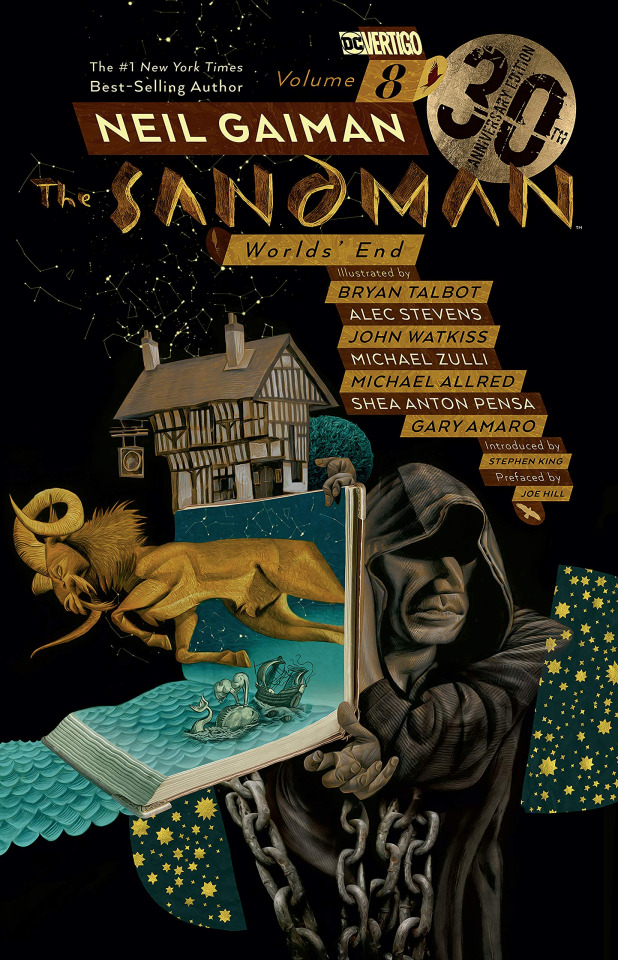
The World’s End features a strange interdenominational inn that transcends time and space and serves as a refuge for the displaced during ... er... Let’s just call them what DC comics calls them. “Crisis.”
This is a collection of short stories from characters who have all been touched by Dream and his world in some way. My favorites include Cluracan’s story and Hob’s Leviathan.
There’s also some heavy foreshadowing for The Kindly Ones.
10. The Dream Hunters (Graphic novel version).

The Dream Hunters is a stand alone story set in Ancient Japan and works as a bitter-sweet fable.
9. The Dream Hunters (novella version.)
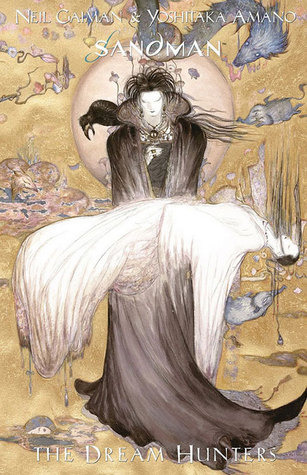
I like the novella version of The Dream Hunters better than the graphic novel version because the artwork is just so gorgeous.
8. Fables and reflections.
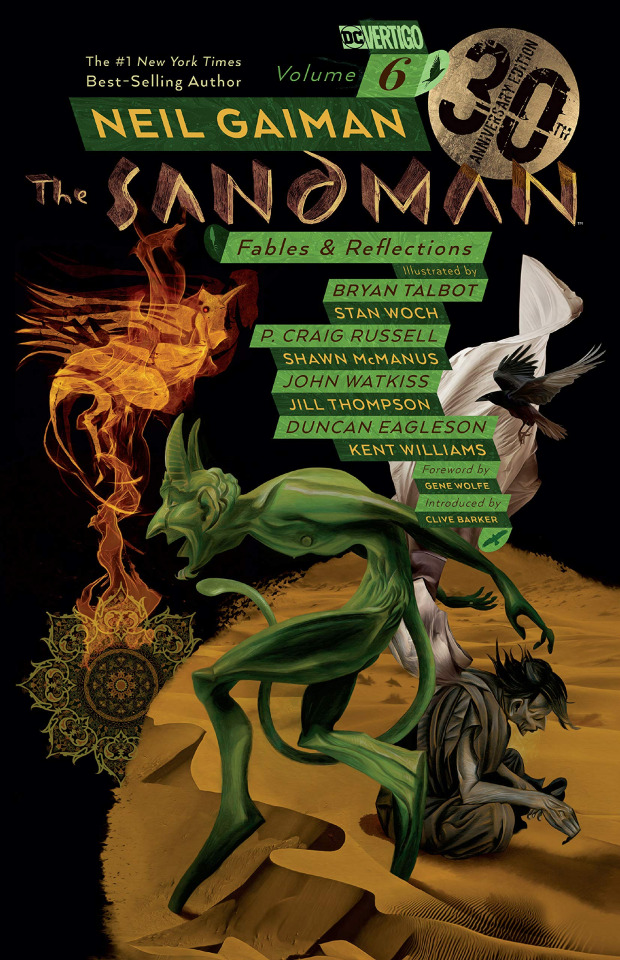
Here is another collection of short stories all tied into The Sandman. Most of them can be read on their own.
7. Dream Country.
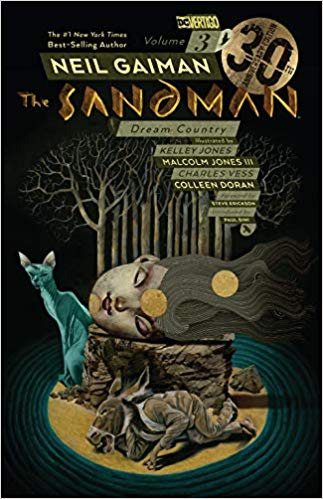
Here’s another set of The Sandman short stories that can be treated as stand alone one-shot stories. My favorites of these is A Midsummer Night’s Dream, which is a brilliant and off-beat Shakespere story in which Shakespeare is made to perform a Midsummer Nights Dream for the real Seelie Court.
I also liked Calliope because we get to see Morpheus as a sort of avenging angel type.
I happened to be reading A Dream of Cats for the first time on the very day I adopted Loki and Vlad (two of my three cats). This was not planned out, just a strange coincidence.
6. A Game of you.
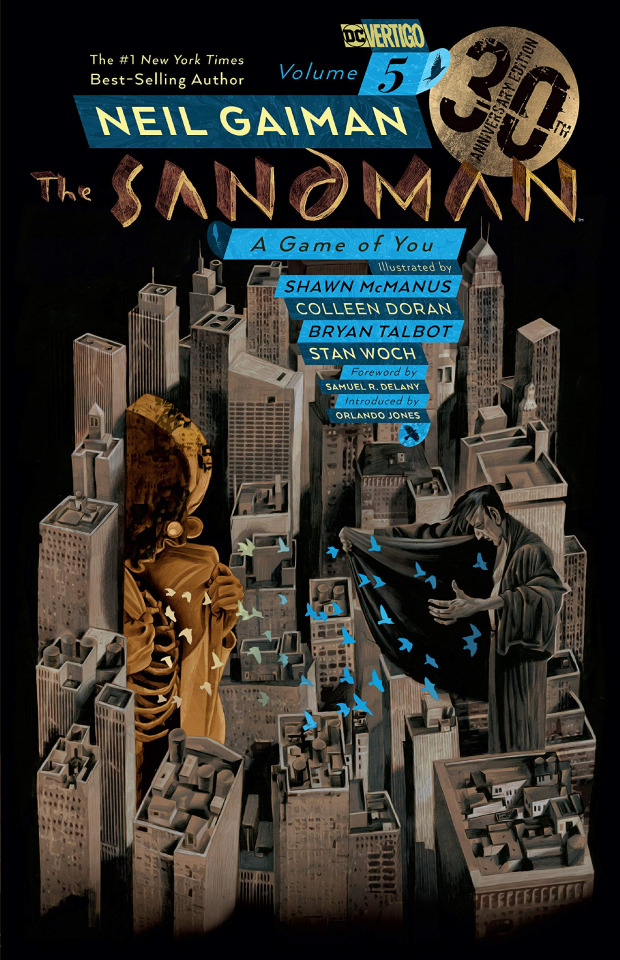
This is probably the most misunderstood volume of The Sandman. Though Neil Gaiman based it on the personal experiences of a real life trans friend of his, whom consulted with him through the writing of it, many modern readers (mostly thanks to a very misleading Mary Sue article) have called this volume transphobic.
In actuality for 1992 this was an extremely progressive depiction of a transwoman and one of the first (if not first) trans women of DC comics.
Some of the complaints are because Wanda dies (many characters in The Sandman die, including the main protagonist...) while others think that the story claims transwomen cannot use feminine magick. This is not true. That was a claim made by a very dark witch, Thessaly AKA Larissa, a character who later betrays the series’ over-all protagonist. She probably should NOT be trusted.
The scene showing Wanda’s soul pretty much confirms how wrong Thessaly was.
The story deals with Barbie on a Jim Henson’s Labyrinth-esque adventure in her own personal dream world, and her friends who come to her rescue.
5. Brief Lives.
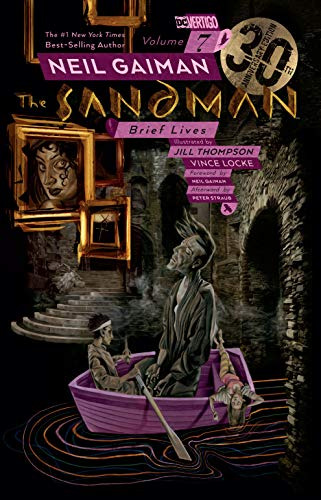
Brief lives is the story that tells us what happened with Destruction of the Endless. It is beautifully drawn. And this is where Song of Orpheus finally comes to its bitter-sweet conclusion as Morpheus enables his poor son to find peace at last.
4. The Doll’s House.
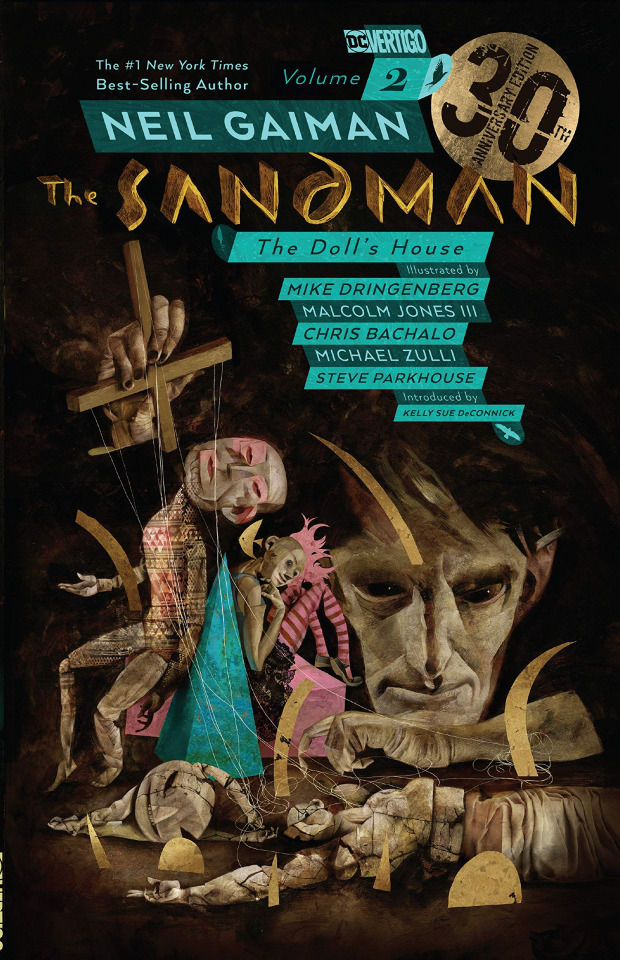
The Doll’s House gives us the story of Rose Walker- a person who is also a “Dream Vortex” (A person whose mind has the potential to cause dreams and reality to collapse into each other and destroy both) and how dangerous that can be. We are also introduced to The Corinthian, a Nightmare who could give Freddy Krueger a run for his money.
3. Season of Mists.
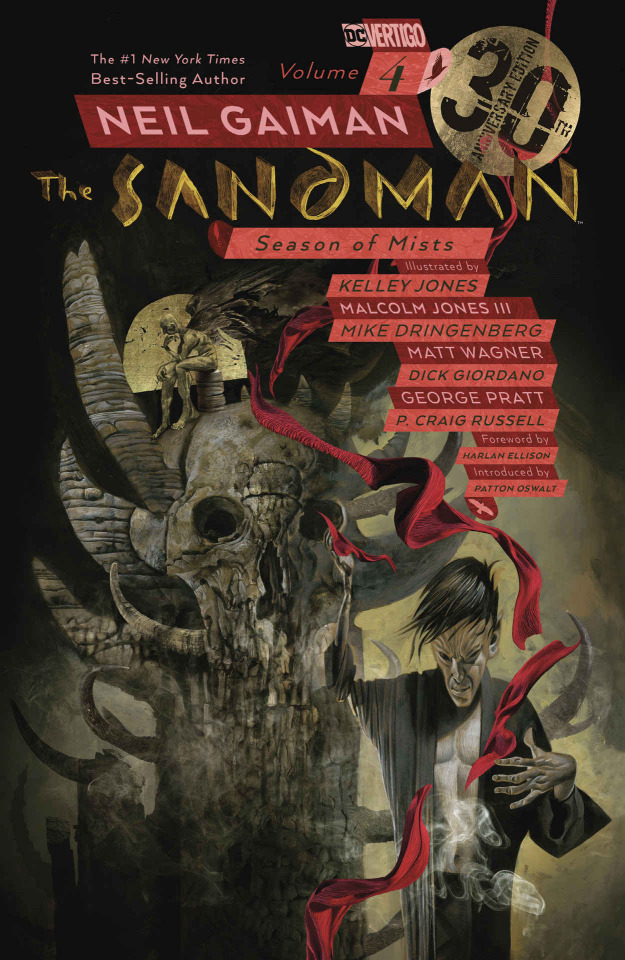
The Sandman: Season of Mists is a storyline that some Lucifer show fans might recongize. The Devil decides to quit. There’s a lot more to it than that but Lucifer quitting ruling Hell is the catalyst for most of it.
After finally (after ten-thousand-years!) realizing he was wrong in leaving Nada in Hell, Morpheus resolves to rescue her, at risk to himself. However once he gets there he finds Lucifer is shutting the place down. In spite, Lucifer leaves Morpheus the key to Hell. Suddenly The Dream Lord has to deal with all the entities that might want that “Prime psychic real estate.”
2. Overture

The Sandman: Overture and The Sandman: Preludes and Nocturnes are both my favorite volumes of The Sandman. I tend to alternate between which one is number 1 based on my mood.
In The Sandman: Overture Morpheus discovers that The Universe is ending and “It’s all his fault” for refusing to put out a star back when he was reeling at the destruction of a world because he had not wanted to kill a Dream Vortex (a person whose mind has the power to merge dreams and reality).
Now he’s off on a quest with a cat (whom he believes is another incarnation of himself). He adopts an orphaned child, and sets out to save the universe.
This is probably the most gorgeously drawn of all of The Sandman. The print is a little difficult for me to read (Impossible for me to read in physical format) but I can make the digital version large and enjoy the story and all the lovely detail in the artwork.
1. Preludes and Nocturnes
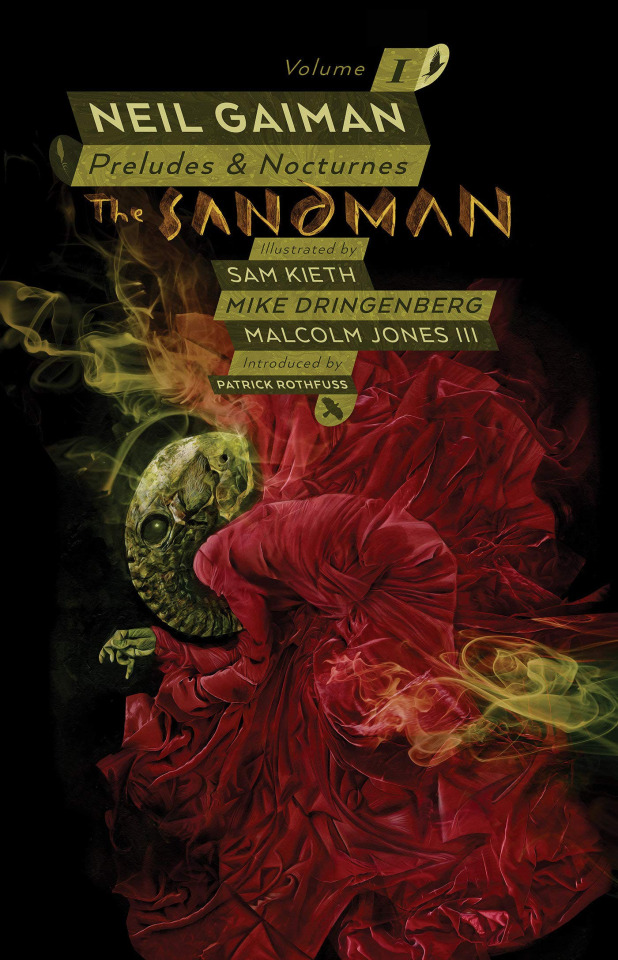
This is the one that starts it all. An order of early twentieth century occultists summon and trap The Lord of Dreams by accident when they meant to capture Death. Though they realize their mistake relatively quickly they decide to keep him prisoner anyway. After seventy-two-years of captivity Morpheus finally escapes and seeks out his lost property.
This is the one that roped me and made me a fast-fan to The Sandman.
5 notes
·
View notes
Text
The Sandman conspiracy
So I got into the Neil Gaiman’s Sandman fandom three months ago (Better late than never!) and maybe I’ve hit the denial phase of the grieving process but honestly these suspicions have been haunting me since I read Sandman back in June.
I don’t think Morpheus is dead... There, I’ve said it. I know there are Sandman fans who say that Morpheus being “resurrected’ or “revealed to be alive” ruins the ending but what if his survival was woven into the story all along?
At first glance Daniel feels like a redemptive / Doctor Who style regeneration, a version of Dream forgiven for his past and able to move on from it. And this works- at first glance. He has Morpheus’ memories and he claims he’s the one Cain always had his contract with. And Cain and Abel even say that no one died, what died was a point of view.

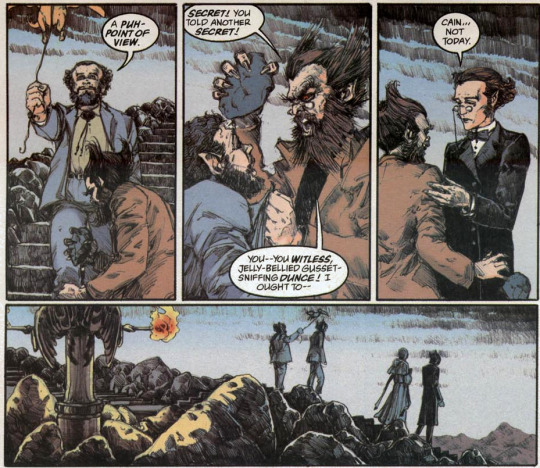
Buuuuut... we’re told over and over again he’s not Morpheus but he IS Dream. Daniel, the baby that was transformed and is now Dream of the Endless.
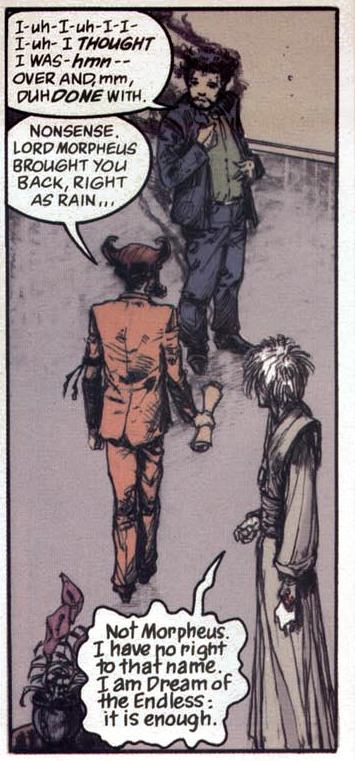
And yes, I get that Morpheus is just an aspect of a greater whole. A facet of a being that is essentially a giant crystal made up of smaller facet entities.
Now, aside from Daniel-Dream being rendered a complete self-congratulatory moron in The Dreaming spin-off “I did not interfere because I did not want any martyrs.” (Among nightmares?!) Note: I cannot forgive the writing that had Nuala going back under that glamour as a form of “empowerment” or Matthew’s idiotic and pointless death, or Goldie’s Pokemon‘s Cubone backstory, or Echo being shoved down our throats but I digress...
I can’t help but feel that bread crumbs were laid to show that all is not as it seems in the realm of Dreams.
Item 1. When Abel is murdered by The Kindly Ones (issue 66, part 10 of the Kindly Ones) he tells them that they cannot kill. They can push their victims to suicide and they can push the victim to repent their sins but they cannot kill. They argue that he barely counts as alive and wouldn’t truly be dead unless Morpheus was killed anyway.

They say Morpheus, not Dream. They said the name Morpheus. The names have significance and importance all through this story. This can’t just be a slip up. Regardless, Daniel is able to bring Abel back exactly as he used to be, either via the memories he inherited from Morpheus or the piss-poor description given to him by Cain in his habitual bashing of his beloved brother. Would this have been possible if he was truly dead as The Kindly Ones inferred?
Item 2. And this one is a big one, perhaps the biggest one. Hob AKA Robert, Morpheus’ immortal friend, has a peculiar dream shortly after Morpheus’ Death. This is in The Wake Epilogue Sunday Morning, issue 73. Robert Dreams of Morpheus. This is important.


A. Wouldn’t dreaming of someone like Morpheus make him live again even if it’s as a Dream Entity? He- is- Alive.
B. Did Daniel recreate Morpheus as a Dream entity for this dream? Even if it means he’s been reinvented as a Dream Entity instead of as Dream of the Endless wouldn’t that mean Morpheus exists once more but free of being Dream of The Endless? Was that his whole plan? To die and then be re-created by Daniel so he could escape his role as Dream of The Endless?
Is he living on Earth now under the name of Neil? I wonder... (This question is asked with tongue firmly in cheek. I’m just still amused by the physical similarities. I do NOT think Neil Gaiman is literally a preternatural being.)

C. Doesn’t this mean at least a version of Morpheus has to exist? Even if he is now a Dream entity he exists. We’re told over and over again that it’s never just a dream. Such as with Constantine in issue 3.
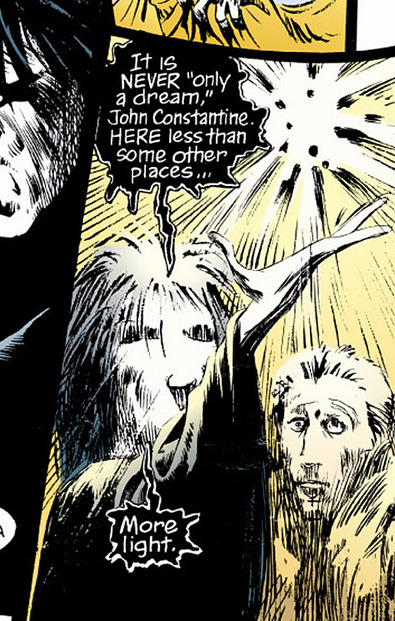
In fact that comes up in Exiles (issue 74) that nothing is truly lost. That’s a recurring theme in these comics.
D. Destruction / Creation. Destruction was in Hob’s dream. Hob / Robert never met Destruction. He mentions that man looked like a lousy painter he saw once but never made that connection that the painter was one of Morpheus’ siblings. One of the last times Robert dreamt of Morpheus was when Morpheus was going to Hell to rescue Nada and Morpheus had wanted to say good bye. This time he saw Morpheus walking off into the sunset with “the painter.” Was Morpheus giving Robert a farewell before he wandered off, having essentially done as Destruction and Lucifer had? He resigned but he had done it in such a way that he was free from being Dream of the Endless yet there still was a Dream of The Endless to take care of things?
E. If Morpheus died and Daniel became Dream of The Endless but brought him back (perhaps as a Dream / Nightmare) that means Morpheus would be free of being Dream of The Endless, yet alive and have already paid his price to The Kindly Ones in his original death.
F. Also if not Creation than Change. Destruction became “Change” as we saw by his meal preparation (even if it wasn’t a very good meal). Morpheus walked off arm in arm with Change in that Dream. So ultimately if the moral is “Change or die” he did choose Change after all.
G. Why / How would Robert have dreamt of Morpheus being with Destruction when Robert had never known the painter he once encountered was Destruction? That means the dream isn’t purely the product of Robert’s grieving, like when he dreamt of his lover who was killed by the hit and run. That can’t be from Robert’s imagination. If the dream was from Daniel why would he concoct this? Why include someone Robert doesn’t know unless he’s trying to tell Robert something and used Robert’s dreaming as an excuse to resurrect Morpheus? A version of Morpheus outside of Daniel lives. He has to or that dream could not have happened.
H. Remember Destruction’s quest to become a force of creation, to finally embody that “other side of the coin” as he believes all The Endless represent an aspect of sentient life and it’s opposite counterpart. What if he’s finally done it? Destruction is also change / Creation and he helped bring back his own wayward brother?
I. Notice how Death isn’t there but Destruction is. This stands out because when Wanda gave her ghostly farewell she was standing with Death. This suggests that Morpheus is not dead as he is not with Death now. The Destruction of his old identity and birth of a new one perhaps? Change.
J. Daniel has no personal attachment to Hob / Robert. Morpheus does. Why would he be given this sort of dream unless Morpheus, himself, wanted Robert to have it? (Or if Daniel inherited that attachment when he became Dream). One of the last times Robert dreamt of Morpheus it was right before Morpheus went to Hell to try to rescue Nada. But if the dream is from Morpheus that very much means Morpheus has to be alive. This was set after Morpheus’ death.
K. I don’t think anyone just dreams of The Endless. Especially two of them, one of which he had only known as a random artist. Daniel created this dream for a reason.
Item 3. A Dream of Cats, and Sandman: Overture have repeatedly told us that all it takes is a thousand souls to all dream of the same thing all at once to make it so. Sandman has over a hundred million readers world-wide. Neil Gaiman, himself, has said so. Wouldn’t we have dreamt him back to life by now?

Item 4. In Sandman: Overture all the different “Aspects of Dream” meet in the Edwardian era. Each one is a different persona, a different incarnation of Dream of The Endless.
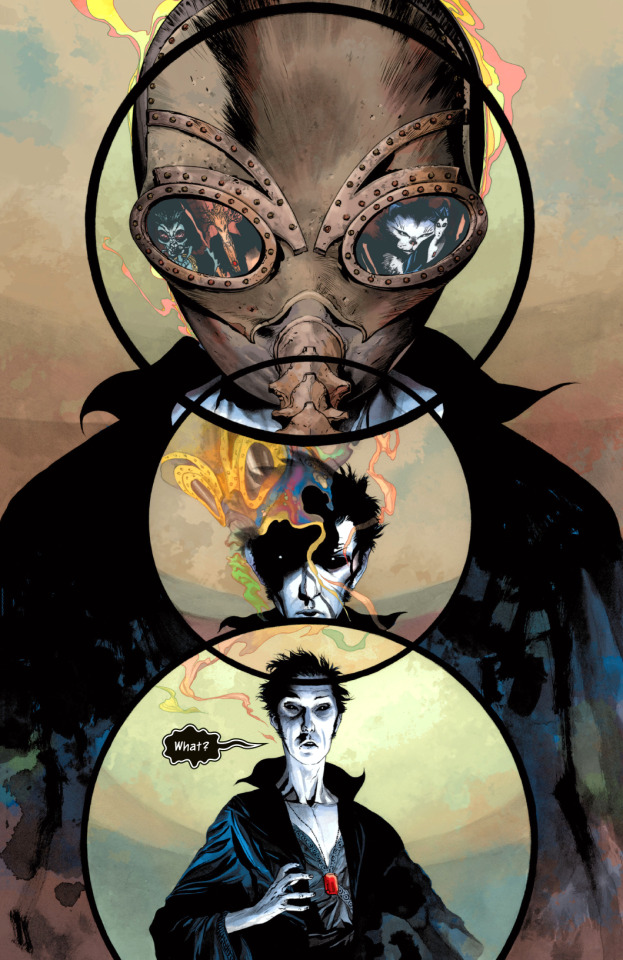
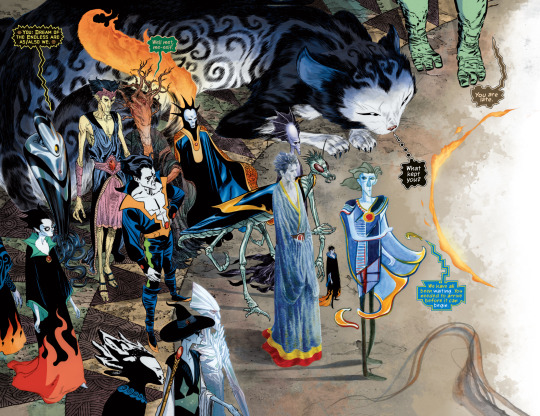

But they are not all Morpheus. In fact they have enough autonomy and individuality and separation that for most of the story Morpheus mistakes Desire as a Cat incarnation of himself and none of the others are lost when the flowering version of Dream was killed.
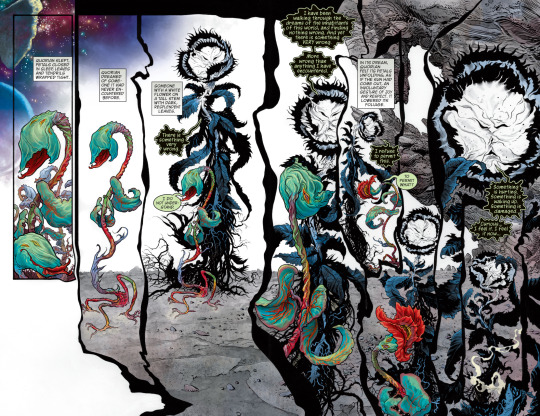
So that means theoretically that though Daniel is Dream of The Endless he CAN co-exist with Morpheus eve if they both are Dream of The Endless (or if Morpheus has freed himself from that burden). Hell, they could even live in the same castle and not have to run into each other.

Morpheus always wanted a companion that was more like himself. What if Daniel should have always been that companion and not his replacement? Someone to ease the burden of ruling The Dreaming and to co-run things with him.
All this time and it still feels like Neil Gaiman is writing ways to possibly bring Morpheus back, as if he’s struggling (and failing) at keeping him dead. Just let it go. It’s all right. Let him live again.
Item 5. Morpheus is a master of illusion. He has created illusions so elaborate that they have tricked and deceived Gods, such as when he created the illusion of Loki to suffer under the snake, after he freed the Japanese Thunder God (that Loki swapped places with) all while Morpheus let the real Loki run free. It took some time for Odin and Thor to realize it wasn’t Loki under the snake but an illusion.

Item 6. What DID Morpheus and Loki talk about in private after Loki agreed to be in his debt? Why was it not covered in the comics? We have seen Loki kill people rather than be in anyone’s debt but suppose- just suppose the old trickster somehow did pay his debt in taking part in an elaborate charade?
If Morpheus faked his death, it would not be hard for him to do, nor would it be impossible to trick The Kindly Ones the way he tricked Odin and Thor. If Morpheus is somehow alive but no longer Dream of the Endless (or at least no longer acting as Dream of The Endless) who or what is he? Did he settle on Earth and become a best-selling fantasy writer? (Again, this part is just a joke because the physical similarities amuse me. I really shouldn’t have to keep posting this disclaimer. It spoils the joke.)

Item 7. Fiddler’s Green / Gilbert gives this annoyingly pretentious speech about why he shouldn’t be raised from the dead, because then his death loses all meaning so Daniel halts mid-way through resurrecting him even though choosing to stay dead kind of already gives his death no meaning. Life is what gives life it’s meaning, Gilly, not its death.


I initially took this scene to be Neil Gaiman using Gilbert as his mouth piece to lecture DC / Vertigo to not resurrect Morpheus but what if the reality is he only doesn’t want them to resurrect Morpheus because Morpheus never truly died as Abel implied. “What died is a point of view.” This also grants that indefinite safety net that Morpheus can’t fall victim to substandard writing quality like certain other characters have. Isn’t that right, Danny?

(Disclaimer, I don’t consider this above image to be an example of Daniel written badly.)
Now here’s the important part. If we go by issue 19 of House of Mystery Volume 2 it appears Daniel brought Fiddler’s Green Back anyway, despite his pretentious protests. Could he have brought Morpheus back despite his protests?
Before I proceed I am going to say something potentially controversial in the Sandman fandom. I HATE the scene.where Gilbert refuses to be brougth back.
I love Sandman. I think it’s a gorgeously written work that I am deeply fond of but I hate that scene.
I hate that scene more than words can describe. I like Gilbert but this scene… This scene… His lines are pretentious and draw me out of the story entirely. It is the only moment of Sandman where I feel knocked out of the lush and beautiful story given to us by Neil Gaiman and knocked over the head with a commentary that doesn’t really feel like it fits.
Anne Rice fans suffer this sensation in the very first chapter of Blood Canticle and I, as a Sandman fan, suffer it here.
First, a death seems to have meaning because it was a terrible occurrence. The one who died still suffered it. Still gave their life for a cause. If they are brought back to life that doesn’t undo what they suffered. It doesn’t change that they thought they would not come back. It doesn’t change that they were mourned. And it doesn’t change that they died without any knowledge or belief that they would come back. It doesn’t change that sense of loss that was there at the time of death. That cannot suddenly be erased.
Joss Whedon handled resurrection surprisingly well in Buffy The Vampire Slayer Season six. Was it the best season of Buffy? Probably not. It had it’s flaws- glaring ones (i.e. Spike’s near rape of Buffy) but it had its good points too. The way Buffy’s death was handled was one of its good points.
You can watch Buffy The Vampire Slayer Season five and still feel the weight and impact of Buffy’s death and sacrifice. You still feel the grief of her friends. Just because she comes back a season later doesn’t undo this, it doesn’t change that she didn’t know she’d come back, her friends didn’t know, and coming back- in and of itself, was traumatic.
You can’t undo a great story just by bringing back a character who died. If the story is that fragile it wasn’t very strong to begin with, was it?
Resurrections, themselves, can be traumatic and devastating. Buffy suffered because of her resurrection, ripped from a place of peace and comfort (“There was no pain, no fear, no doubt ‘til they pulled me out of Heaven… I think I was in Heaven…”) And as a result her death still packs a powerful wallop.
Gwen Stacy was brought back in the Spider-Man comics (and later killed again…) but in that time people still wince and gasp when they revisit her first death, or watch the film version with Andrew Garfield as Spider-Man.
Most Game of Throne fans theorized that Jon Snow would come back but the death was and is still agonizing to watch. The resurrection doesn’t change that. In fact there’s trauma tied to that resurrection because it damages the soul and there could be other side effects later.
If something is truly well written than nothing can undermine that. Nothing can take away the original impact. That will always be there no matter what. Sandman is such a work.
Sandman is brilliantly written. If Morpheus ever comes back there needs to be two stipulations. 1. The impact of his death and resurrection would have to be handled with the utmost care. And 2. (And this is a given) Neil Gaiman himself would have to write it. There is no one else who could be trusted with it. But if (this is a hypothetical if) if Morpheus ever came back I don’t think that could ever harm or undermine the original story. It’s just too good to be that fragile.
I lost my mother to cancer. I lost my stepfather to a drug overdose (that was probably suicide). I lost people in my life and I won’t romanticize it. I won’t pretend that the way they died had great meaning or purpose. I miss them and sometimes resent. I resent that my mother was a chain smoker. I resent that my stepfather wasn’t stronger for my little brother who still needed him. I miss the good times.
When we mourn, we don’t mourn because of how the person died, we mourn because they are no longer alive. We mourn the life. We mourn the things that never were- the potential that never came to pass. We mourn not having them there in our own lives anymore.
Life is what gives life it’s meaning, not the death. Life doesn’t have value because it ends. If you can’t find value in life without the fear of it ending, I don’t think you truly value it. Life - really living is the appreciation of physical sensation, intimacy, connection with others, culture, art, history, all of that. Life is what gives life value, not its ending.
Too many works of fiction talk about immortality as a great tragedy.
“Woe is me. People I love will die.” We mortals experience that too, constantly actually. Stop acting like we don’t suffer loss. That’s a pretty big part of the human condition.
“Alas, I cannot find value in this because I have lived so long and have experienced all possible things already.” (I hate this trope!)
Oh, bullshit. You’re five-thousand-years-old. I doubt in those previous centuries you experienced binge watching Stranger Things Season two on Netflix while eating Pop Secret Homestyle Popcorn as you sit in a bean bag chair in a New York City apartment while it’s snowing outside. Bronze Age hazelnut pudding while watching hogs wrestle each other for grubs in the afternoon sun doesn’t count. Now shut up and pass the popcorn before I give you another “experience” you probably didn’t have centuries ago.
To quote a certain Disney musical: “There is more to be seen than can ever be seen, more to do than can ever be done.” LIFE is what gives life it’s purpose, not its death, not the looming dread that you can die. But the infinite possibilities that come with simply being alive.
Gilbert (in those above panels) is romanticizing his own death. No, Gilbert, your death didn’t have meaning. Even if it did, your insisting on staying dead undermined that meaning entirely. It turned it into nothing more than pretentiousness.
And that’s why I’m kind of glad we get this throw away line here in House of Mystery Volume 2 issue 19 suggesting that Daniel didn’t listen to him after all…

Gilbert is Fiddler’s Green. He’s a place in The Dreaming with sentience. The place wouldn’t exist unless Gilbert was brought back from the dead despite what he wanted. And Cain would know this.
Ha! Thank you, Cain! In one talk bubble I feel a certain vicious pleasure in knowing Mister “I must stay dead for my death to have meaning” was unheeded. Is that cruel? Perhaps. But honestly I don’t care. I don’t like when death is treated like the only way a life can have value. And honestly, this throw-away line doesn’t undo any of the impact of reading the end of The Kindly Ones arc in Sandman or The Wake. Hell, even Daniel bringing back Merv Pumpkinhead doesn’t undo how I felt when I saw the poor guy get blown to bits. And even when Goldie wailed for Abel I still feel for the little guy though I know Daniel brought Abel back fairly quickly.
Gilbert’s own speech about wanting to stay dead, in my opinion, did more harm to the sense of loss about his death, than the House of Mystery Volume 2 implication that he was brought back anyway.
It’s Gilbert’s little speech that, I feel, lead to the craptastic death of Matthew in The Dreaming spin-off comics, which not only felt unnecessary but also felt like a bad rip-off of The Wake from Sandman. So yeah, I kind of resent Gilbert / Fiddler’s Green a bit. And he was such a sweet-hearted character for the most part too…
Death is a big deal. It’s important. It’s painful buuuut it’s not what gives life its purpose and it doesn’t suddenly increase the value of that life or how deeply someone is mourned. That mourning comes from what the person did while alive, not merely that they are dead. The mourning is for the potential of what might have been, and for the experiences you will never have again with that person (or in the case of character resurrection) what the characters and reader thinks they’ll never have again.
I’ve met too many people who wax poetic about death and I’ve seen too much in the way of suicides and suicidal people in my own real life.
I have a friend I’ve had to stop from doing harm to themself- have a friend I’ve had to call their mother in the middle of the night to keep them from doing something awful. I’ve had to deal with said depressed friend rant and rave and even lie because they were angry I stopped them and pretend I somehow misunderstood what was going on… And eventually apologize to me and admit that they were going to kill themself. And that is brutal to endure.
As people like Voltaire (the musician) can tell you, this is all too common in the Goth / Gothic community. People who relate to Gothic fiction thinking they have no way out in bad situations and then they read poems and stories where death seems to be the answer, because when you feel that way, you are drawn to works of fiction that reflect how you think and feel. It’s why Voltaire had to write a song like Feathery Wings, because he has seen it and experienced it first hand, that sense of helplessness and had to overcome it and persevere. We need more hope.
So I’m tired of fiction (particularly Gothic fiction) treating death like some great way to end a story. I love Gothic fiction. Is it wrong to want to see Gothic fiction with a little hope?
I love all things Gothic but I’m tired of Gothic fiction treating death like it’s something better than being alive.
“To die. To truly be dead. That must be glorious.” - Bela Lugosi as Dracula. Did no one realize that was the first emo vampire quote?
I may love Gary Oldman’s Dracula and Frank Wildhorn’s Dracula musical, but I feel Fred Saberhagen’s Dracula books and Frank Langella’s Dracula blow them out of the water. Why? Because ol’ Drac can be made sympathetic and realistic without wanting to die. He likes being alive despite what he does. And I appreciate this. In fact I love it.
It’s irresponsible to treat death like the best possible turn out for a character, to not hold value to the life itself. It’s not death that gives life its meaning. It’s life that gives death it’s meaning.
When you die I imagine these questions for the newly fledged ghost. Did you live well? Did you taste all that you wanted to taste? Did you have good sensations? Were you loved? Did you do anything to make the world a better place because you were in it? Did you help others? Were you kind? Life is what gives life its meaning.
Romeo and Juliet may be tragic but I’m far more satisfied by the end of A Midsummer Night’s Dream. And honestly Romeo and Juliet’s deaths ultimately always felt so senseless to me…
In Sandman I hate that no one was able to make Morpheus value his life despite his grief and loss, that there was no one to comfort or console him. I hate that no one (save for Madness herself, little Delirium) tried to save him. I hate that he felt like death was the only way he could reconcile his past. I hate how alone he was even when Matthew tried to stay with him in the end. I hate that the character underwent all that change and beautiful character growth and evolution and still “had to die.” (Whether he literally died is debatable and subjective but you know what I mean).
Death doesn’t have to be cruel. Death isn’t ugly. The embodiment of Death in Sandman is beautiful and simply fulfilling her purpose but she tries to be kind, tries to be a friend. And she may also represent life. The Ankh isn’t truly a symbol of death after all. It’s Life Eternal. She’s not treated as a cliche and yet here we get the old Gothic literature cliche.
It’s a petty thing to treat death like the ultimate way a story should end. And I’m tired of it. I’m tired of death (the action / event, not the anthropomorphic personification).
I’m not a fan of repeated comic book deaths and resurrections. I never want Morpheus to be treated like Wolverine up to his umpteenth death in Marvel comics. But I’m honestly tired of modern Gothic fiction feeling like the protagonist must die for the story to have purpose.
Look at what they did to Showtime’s Penny Dreadful. That wasn’t deep and meaningful. That was senseless and petty. The romanticism of killing characters for “purpose” or because they can’t bear to be alive is ugly, overrated, and done too often. I hated how Penny Dreadful ended, and in fact I felt that Vanessa’s Death spoilt and undermined a certain potential to break the most annoying of Gothic cliches.
And yeah, I’m a Sandman fan who kind of hopes Hob’s dream wasn’t just a dream and that Daniel may have ignored someone else’s protests about probably not wanting to be brought back…
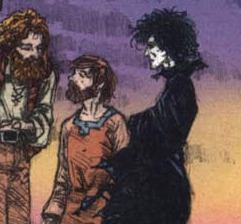
To Hell with wanting to be dead.

Life matters. Your life matters. Keep living. Even if it’s hard, keep living. You’ll find the good eventually. These are the things people need to know, in fiction and reality. It might be hard. It might hurt but there’s good too. There are things worth knowing even in the agony of loss. There are things nothing can take away.
Hope is never truly gone. Where there’s life, there’s Hope.

Never, ever let go of Hope.
Anyway, I went on a bit of a tangent there. Sorry about that...
Item 8. Morpheus wanted to quit.

Morpheus did not want to be Dream of The Endless anymore but he felt bound by his obligations and responsibilities. He witnessed Destruction essentially quit and Lucifer retire to Earth.

But Morpheus felt he couldn't do that. At least not so long as he was Dream of the Endless but what if he found a way to exist but not as Dream of The Endless?
Item 9. Desire can enter The After Life. This might not mean much (If Anything) but in Sandman Overture we learn that Desire can, not only enter the after life, but also pull souls out of the afterlife, as he / she does with the ghost of little Hope in Overture.

Item 10. “And nothing is truly lost.” These are the lines issue seventy four (Exiles) ends on.

Item 11. “Tired.”
Morpheus tells Death that he’s tired. And I already brought up how that is what Lucifer said before he went to Earth but it was also Gilbert / Fiddler’s Green’s explanation as to why he left to Earth. Until Morpheus says it, every character who said they did something because they were tired, it’s an immortal being going to live on Earth as a mortal. Is Morpheus Neil Gaiman?

Item 12. Remember what Morpheus said on the flight in Brief Lives?

He tells her that you can stop being anything. I got the impression Morpheus doesn’t want to be Dream of The Endless anymore but that is not quite the same as not wanting to be alive.
Item 13. Nuala’s quote about running.

Item 14. Stars. During The Wake issue 72 “The Lost Pages” we see / experience a spiritual assertion ending with the implication that Morpheus’ essence may have become a star now watching over The Dreaming. Thanks to Sandman: Endless Nights and Sandman: Overture it is confirmed that in The Sandman continuity, much like in Stardust, the stars are never just stars.

In fact, according to “Little Endless” (Debatably canon) Morpheus’ sigil before creating the helm, had been a star.
Item 14. It’s my understanding that Neil Gaiman has repeatedly said that Morpheus had to choose to change or die and “he made his choice” but has he ever specified “he chose to die”? Has he ever literally used those words?
Item 15. Morpheus compares Dream of The Endless (as a whole) as a crytal or jewel and each aspect is a facet. He is a facet. And he talks about how if you move the Jewel you will see yet another facet and that facet isn’t the whole but part of something much bigger. However a facet damaged on a crystal or jewel weakens the whole thing, causes a permanent damage. For the jewel to be repaired it would have to be entirely reshaped, otherwise you have a horribly damaged rock. ...Unless the jewel is merely turned and the original facet being isn’t replaced but just now hidden...
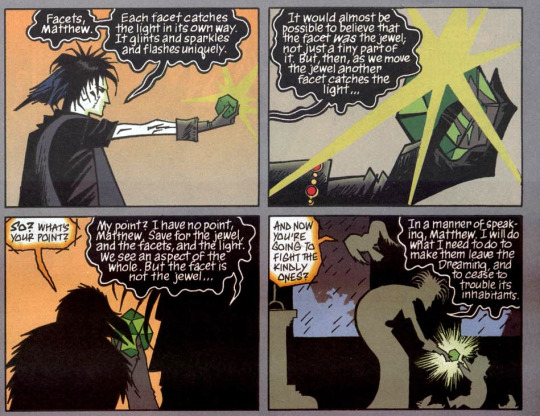
Item 16. What death? Matthew died in The Dreaming spin-off but now no one remembers that he has died and no one brings it up. But to be fair that was a pretty awful comic and it didn’t deserve to be canon. My point is if they ever do bring up Matthew’s death or explain why he’s back (though I doubt they will) the same could theoretically be done for Morpheus.
Item 17. Cluracan’s dream. Cluracan was rescued by Dream. He told the story when time was distorted at The World’s End inn. But in The Kindly Ones Morpheus and Nuala don’t seem to remember it. This indicates that it has not happened yet. But at one point would there have been time for that to happen before Morpheus’ death? The only explanation I can come up with is Morpheus is not truly gone because he would have had to make that visit later.
Item 18. And then there’s Neil Gaiman himself. Despite “killing” Morpheus in 1996 he wrote Dream Hunters in 1997 then Endless Nights in 2003, Sandman: Overture between 2013 and 2016.
He can’t resist going back to Morpheus. Despite officially ending the story in 1996 he has revisited it at least three times since then. And each time writing for Morpheus. Perhaps I’m mistaken but he only has so much backstory he can write (despite making Morpheus eons old) before he runs out of backstory and will want to write him in present day. Morpheus is an itch he simply can’t scratch.
So there you have it. if Morpheus is ever brought back by Neil Gaiman within the Sandman Universe it won’t be because he’s a sellout. It won’t be because he’s burnt out and run out of ideas. It won’t “ruin” the original Sandman. The clues were there all along. Morpheus is not dead.
Something else to note though not really related. Neil Gaiman claims Morpheus doesn’t pet things but Daniel does. I am pretty sure this is a genuine mistake but Morpheus does pet Cain’s head when he returns from Hell in Season of Mists and he pets the top of Baste’s head when he pays her a visit. This isn’t quite related but I just thought I’d mention it. Unless it was to establish how Morpheus IS changing and if that’s so then how could he have chosen death over change?
Morpheus was changing whether he willed it or not. If your choice is to change or die and he was already changing doesn’t that mean he chose change over death?
#Sandman#The Sandman#Neil Gaiman#Neil Gaiman's Sandman#Morpheus#Dream#Dream of The Endless#The Endless#Daniel#DC#DC Comics#vertigo#Vertigo Comics#Morpheus isn't dead#He chose change#Didn't he?#He chose change.
174 notes
·
View notes
Text
All the DC / Vertigo crossovers involving Sandman (that I know of)
Get ready. This is going to be a long list...

List under cut.
1. The Magdalene Grimoire. First the Magdalene Grimoire, shown in issue one of Sandman. This is used to summon Morphus In 2002 this grimoire is brought up in Green Arrow. A character in the Green Arrow comic book saw Morpheus while he was a captive of Roderick Burgess and the grimoire gets used to raise Oliver Queen from the Dead. (Type of crossover - Sandman into DC proper long after Sandman became Vertigo. Pre-New 52).

2. Lucien / Mr. Raven. Lucien, Morpheus’s librarian is from the 1975 “Ghost Castle” where he was one of the horror host characters. (DC to post Crisis DC / Vertigo).
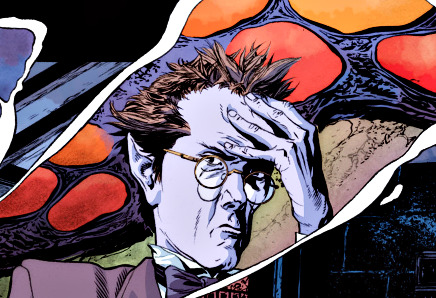
3. Ghost Castle. Ghost Castle was used for Dream’s castle in Sandman. (DC to Post Crisis DC / Vertigo).

4. Cain and Abel, Gregory The Gargoyle, and the House of Mystery. These characters are from the DC horror anthology series “The House of Mystery.” The House of Mystery adn the House of Secrets are byproducts of the 1970s when DC attempted it’s own Tales from the Crypt-style line of comics drawn by the great Bernie Wrightson. The House of Mystery is where you first see Swamp thing’s origin. These characters become a fixture all through Sandman as The House of Mystery and House of Secrets now exist within The Dreaming. (Type of crossover - Pre-Crisis DC existing in post-Crisis DC thanks to Sandman.)

5. House of Mystery: Part 2: In present day DC and Vertigo lore (both versions) Constantine resides in The house of Mystery, which is still inhabited by Cain as it’s caretaker. Cain and Abel’s Sandman related canon is left in tact as Abel is often trying to collect escaped and rogue nightmares. (Because apparently Daniel’s incompetent...) (Type of crossover Pre-Crisis DC becoming Post Crisis DC then Vertigo and then back to DC proper- New Earth).
6. Constantine. John Constantine appears in issue 3 of Sandman to assist Dream in finding his pouch of lost dream sand. It turns out the one who has it is a former lover of Constantine. Both Constantine, Chas, and Chas’ taxi appear in this issue. (Type of crossover Post-Crisis DC crossing over with Post Crisis DC).
7. Lucifer. Lucifer was first introduced in Sandman issue 4 “A hope in Hell” and later became the catalyst for the storyline “Season of Mists” when he quits ruling Hell. Lucifer eventually gets his own Vertigo Spin-off Series that is currently still running. (DC comics turned Vertigo to Vertigo comics.)
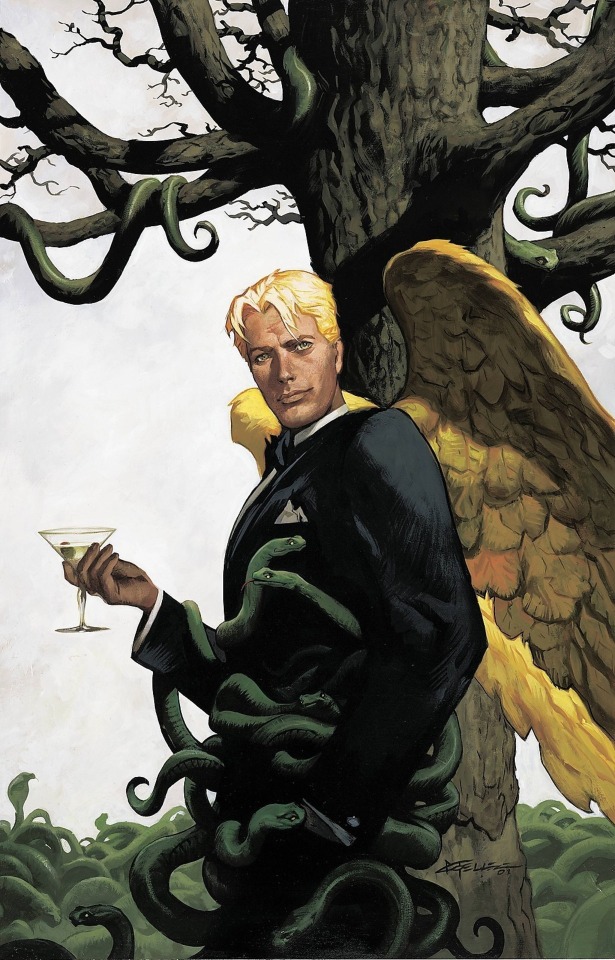
8. Lucifer: Part 2: Lucifer occasionally flashes back to Morpheus around the time Lucifer quit ruling Hell. (Type of crossover DC comic turned Vertigo spawning Vertigo comic).
9. Lucifer and other Angels in Sandman reference The Silver City which is later used on both Vertigo and DC lore, including being the original home of an angel that joins The Justice League of America in the mid-2000s. (DC to Vertigo to Vertigo and DC).
10. Etrigan The Demon. Etrigan The Demon is who guides Morpheus through Hell when he’s there to collect his missing helm.
11. Doctor Destiny. Johnny Dee AKA Doctor Destiny. Doctor Destiny is an old school Justice league villain who had Morphsus’ Dreamstone. (type of crossover. pre-Crisis DC into post-Crisis DC).
12. Mister Miracle. Mister Miracle (Scott Free) from Superman lore helps Morpheus by taking him to Martian Manhunter. (DC to DC)
13. Martian Manhunter. Martian Manhunter assists in locating the Dreamstone. (DC into DC).

14. Arkham Asylum. Arkham Asylum (Batman lore) is where Johnny Dee was confined before his escape. (DC to DC)
15. The Scarecrow. Scarecrow (Jonathan Crane) was at the asylum with Johnny Dee at the time of his escape. (DC to DC)
16. Joker is mentioned. Scarecrow name drops Joker (DC to DC).
17. Pre-Sandman Dreamstone. The Justice League of America had stored the dreamstone in a warehouse after an old defeat of Doctor Destiny (Johnny Dee (Pre-Crisis DC to Post-Crisis DC).
18. Mocking The Bat. During Death’s first appearance in Sandman a comedian dies on stage while cracking jokes about Batman. (DC to DC).
19. Matthew Cable / Matthew the Raven. Over in the Swamp Thing comics (which originally were a spin-off from House of Mystery) the character Matthew Cable is finally killed off but his soul (which was in The Dreaming) is given the opportunity to remain there as a raven to serve Morpheus. Matthew agrees to stay and becomes a permanent fixture in Sandman... until he’s killed off in the crappy The Dreaming spin-off just to give Daniel a matching Raven...). (DC to DC).
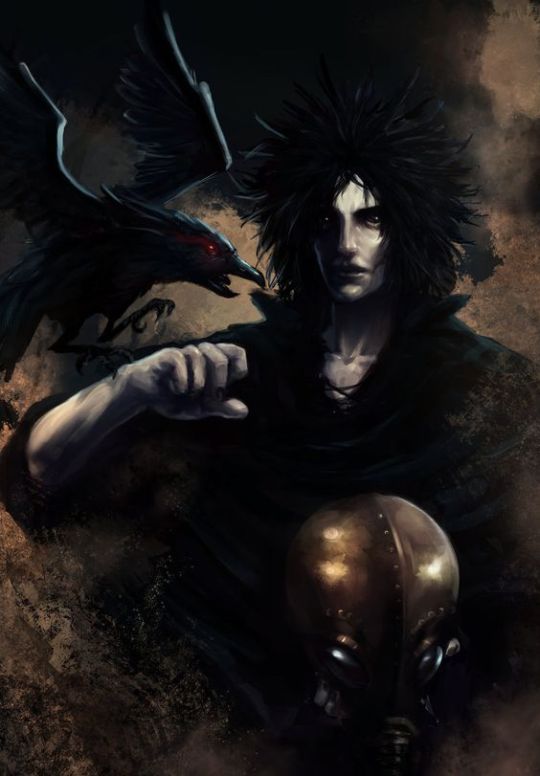
20. Dead Boy Detectives. During “Season of Mists” two little boy ghosts become detectives. These are The Dead Boy Detectives, who spawn their own successful comic book series in the 1990s. (DC to DC / Vertigo)
21. Elemental Girl. A C list hero called Elemental Girl longs for death in an issue of Sandman. (Pre-Crisis DC to Post-Crisis DC).
22. Thessaly. Thessaly AKA Larissa was a pivotal character in the storyline A Game of You and later The Kindly Ones. She later gets her own comic book series called Witch for Hire. (DC / Vertigo to Vertigo).
23. Foxglove. Foxglove the rock musician from A Game of You storyline and her former lover (who appeared in the issue 24 Hour diner, issue 6) also appear in Death’s comic “Time of your Life.) (DC / Vertigo to Vertigo).
24. Death. Death actually has had a few short comic stories including Time of your Life and The High Cost of Living. And The Girl who Would be Death (that one is not by Neil Gaiman). (DC / Vertigo to Vertigo)

25. Death: Part 2. She had a “semi-Canon” appearance in an issue of Marvel’s Incredible Hulk. (DC / Vertigo to Marvel)
26. Death: Part 3: Death appeared in Lucifer’s own comic book series. (DC / Vertigo to DC / Vertigo turned DC.)
27. Death also had a recent brief appearance in Lex Luthor’s comic book. (DC / Vertigo to Vertigo.
28. The Corinthian. The Corinthian (A Nightmare being) got his own short comic. (DC / Vertigo to Vertigo).

29. Merv Pumpkinhead. Merv Pumpkinhead gets his own one shot comic called Merve Pumpkinhead: Agent of D.R.E.A.M. (DC / Vertigo to Vertigo).
30. The Hecatae (who appear in issue 2 of Sandman and are later big players in The Kindly Ones and make an appearance in Sandman: Overture) get their own comic book series called Witchcraft.
31. Lyta Hall is an old-school DC heroine and mother of Daniel (the newest incarnation of Dream). (Pre-Crisis DC to Post-Crsis DC / Vertigo)
32. Hector Hall (Lyta’s husband) and Daniel’s father was the second incarnation of the golden age hero called Sandman. He is Daniel’s father. (Pre-Crisis DC to Post-Crisis DC / Vertigo.)
33. Brute and Glob. Brute and Glob are two old school DC characters retroactively introduced in Sandman as having been Nightmares escaped from The Dreaming all alone and manipulating the superhero called Sandman in order to create a new Dream Dimension during Morpheus’ captivity. (Pre-Crisis DC to Post-Crisis DC.)
34. Wesley Dodds. In Midnight Theatre (published by Vertigo / DC) it was revealed that Wesley Dodds (the Noir style Sandman character from DC) had a psychic link with Morpheus during Morpheus’ captivity which i what gave Wesley his ability to see crimes in his dreams. Wesley’s gas mask may have been modeled to resemble Morpheus’ helm (while behind the scenes it’s the other way around. Morpheus’ helm was modeled after Wesley Dodds’ gas mask). (Pre-Crisis DC to Post-Crisis DC / Vertigo).
35. The Dreaming: Cain and Abel, Goldie the Gargoyle, Gregory The Gargoyle, Death, Daniel, Matthew The Raven, Eve, Nuala, Lucien, Merv Pumpkinhead (and other characters considered to be Sandman characters) had their own spin-off series in the late 90s and early 2000s called The Dreaming. (DC / Vertigo to Vertigo).
36. Destiny (The only one of The Endless not created by Neil Gaiman) had many, many, many crossovers into other DC properties over the years, before and after Sandman.
37. Yup. Still Canon: At Morpheus’ wake Clark Kent, Batman, and Martian Manhunter made appearances. This is important to note because this was after Sandman had transferred over from DC to Vertigo but it established that Sandman was still part of the Post-Crisis DC lore. (DC to DC / Vertigo).

38. Justice League of America (2000s version): In JLA (2008) Daniel showed up at the JLA Watchtower to help with an invasion of Starro. (DC / Vertigo to DC pre-New 52).
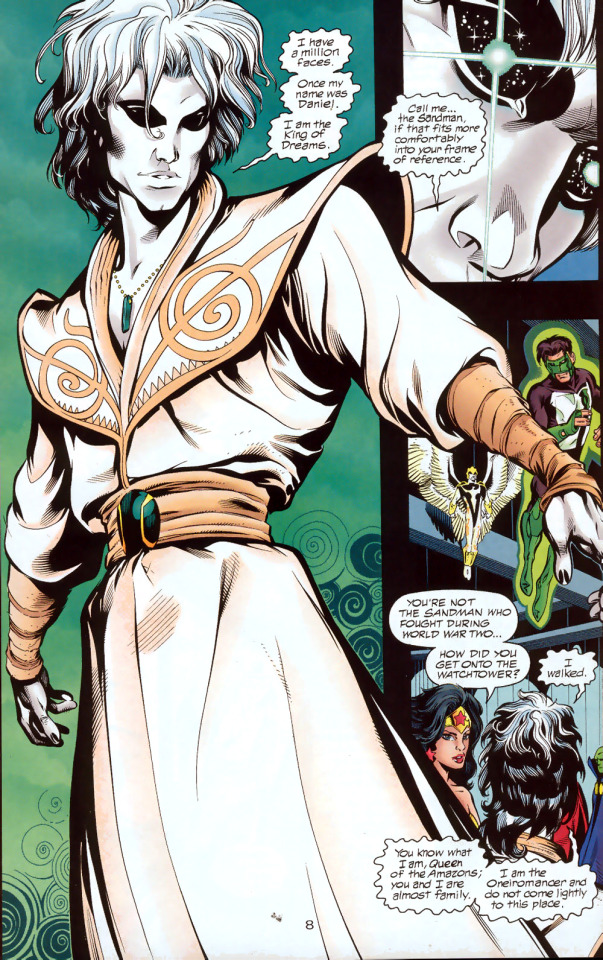
39. Yup. Still Canon: Part 2: Lucifer starts off his 2016 comic book by saying he was wandering The multiverse and thus he was protected against New 52 shenanigans. All of his Sandman related lore was left in tact just as it was for Cain and Abel, The House of Mystery and Constantine. This also seems to ignore Demon Knights. (Post Crisis DC / Vertigo to post Rebirth Vertigo while acknowledging DC New 52).
40. Sandman: Overture: Sandman Overture was meant as a prequel (with some present day content). The publication was repeatedly delayed and the whole thing was not compiled into graphic novel form until November 2016. This established that Sandman (Morpheus and Daniel, The Hecatae, Lucien, Destiny, Death, Desire, Despair, and Delirium were still canon to Vertigo despite New 52 and Rebirth. (DC / Vertigo to Rebirth Vertigo).
41. Carter Hall. Daniel, the current incarnation of Dream is Daniel Hall. Daniel Hall’s grandfather is Carter Hall. That’s Hawkman. So Daniel’s lineage include’s Father, Hector Hall (The sucessor of the silver age superhero The Sandman) Mother, Lyta Hall (Fury), and Grandfather, Carter Hall (Hawkman). (DC to Vertigo to post-Rebirth DC)
42. Dark Nights: Metal. This is the first time since rebirth that Daniel (Dream of The Endless) has appeared in the main DC continuity. It is the first time Batman has appeared in anything Sandman related since JLA in 2008. This thoroughly confirms that Sandman is still DC canon (not just Vertigo) post Rebirth. (DC / Vertigo to DC Rebirth).
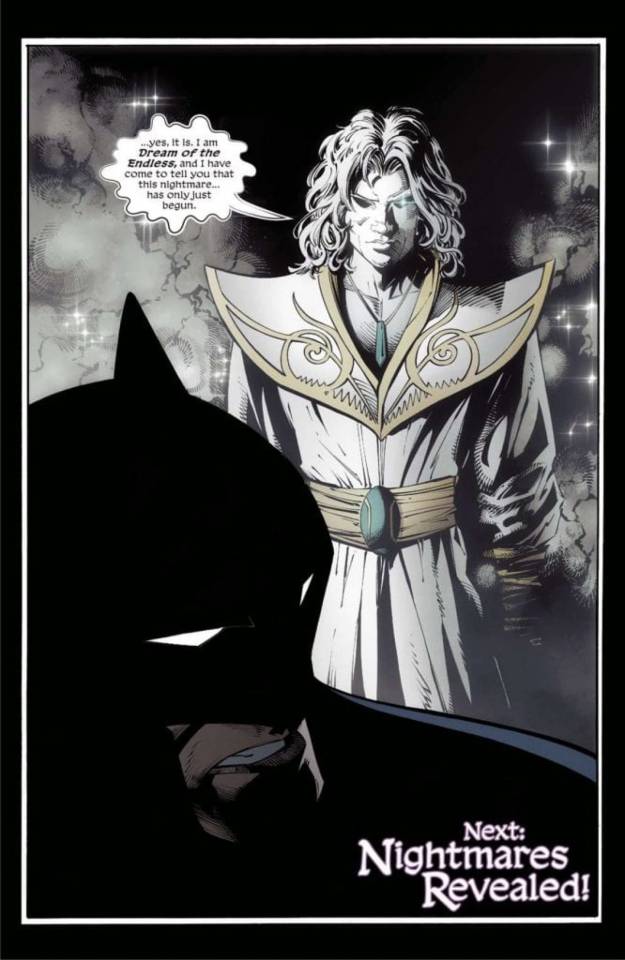
#DC#DC Comics#Sandman#Vertigo#Vertigo Comics#The Sandman#Neil Gaiman#Morpheus#Daniel#Daniel Hall#Batman#Dream of The Endless#Dream#The Endless#Comics#Comic books#graphic novels#Graphic novel#The Dreaming#Cain and Abel#House of Mystery
58 notes
·
View notes
Text
Just read The Dreaming...
So I just finished reading The Dreaming spin off from the Sandman comics. I know it's not Neil Gaiman writing but you can really, really tell. And some of the writing decisions are just horrible.
Cain on trial in the Dream realm for killing his brother (which he does all the freakin' time) and gets banished to Earth which causes people all over the world to become homicidal because our cultural collective NEEDS Cain and able to calm our violent tendencies... really?
Matthew gets killed and chooses to stay dead (for some reason...) even though he's only been a raven for about ten years. And because of this Daniel banishes Corinthian to Earth as a human (where he falls in love and then almost gets assassinated.) Daniel said he would have unmade him but he's not the man he used to be (meaning he's not Morpheus anymore). But the thing is when Morpheus unmade the first Corinthian it was because that one was escaping into our world and eating human eyeballs... Killing and mutilating.
Matthew's soul asks Daniel to make Lucien forget that he felt accountable for his death. Daniel at first refuses, giving a very good and reasonable speech about memories and how repressed memories do more harm than good. But when Lucien considers quitting his post as librarian Daniel DOES Change his memories, via his emerald amulet after all.
Meanwhile Daniel takes the soul of a homicidal new Trans character (whose soul is a black haired woman named Echo) and turns her into Corinthian's replacement. Repeatedly quoting the poem that ends with the line "You can be me when I am gone" / "He can be you when you are gone." (which is used with Daniel before Morpheus' death). When Echo AKA Corinthian 3.0 (Female edition!) later goes wrong and there's a rebellion among several of his nightmares we get a speech about how he (Daniel) would have previously unmade her but he's not quite who he used to be and yet he is. Stop harping on that please.
Also Echo is obviously trans character and the narrator keeps forgetting to use female pronouns. It's really frustrating when Neil Gaiman didn't do that in the early 90s, and this is from 2001.
Nuala goes back to living under her glamour which really, really, really bothers me because her story was about self-acceptance despite what people wanted of her and Morpheus helped her to embrace her true form. And the woman who wrote this can't seem to understand why this is wrong, that she is happiest under the glamour now.
Caitlín R. Kiernan (the main writer) is a bit of a self-absorbed Goth, reminding you all through the series that she’s Goth. I read in her bio that she’s an Atheist Pagan. ...How does that work exactly? Never mind, please don’t answer. You’ll just depress the linguistic part of my mind.
A new wrinkle is added to Lucien's backstory that he used to be a white raven but Morpheus had punished him by staining his wings. This doesn't make sense considering how much Morpheus praised Lucien's loyalty.
Mervyn Pumpkinhead refused to help Cain and Abel when Cain's house was destroyed, claiming it's not really a part of Dreaming and he's only in charge of construction in the Dreaming. He even shows a map, which contradicts established lore that the landscape is constantly changing, like Jim Henson's the labyrinth. Only the castle being in the heart of Dreaming is constant. Some places are always there but their locations aren't always the same. The house eventually is restored, mind you.
Goldie the Gargoyle's backstory is given that Golden Gargoyles are the protectors of stories and when a golden Gargoyle mother lays an egg she dies shortly after the hatching and the baby builds his or her nest with the bones but things went wrong because Morpheus was captive at the time Goldie's egg was laid. Goldie's egg was stolen when her mother died too soon. 1. He's a dream gargoyle. They don't age and die. Dreams don't do that. 2. Isn't this sort of stealing from the Pokemon Cubone?
Also the excuses made to why Daniel doesn’t intervene with half the plots are stupid. When there is a Nightmare rebellion “I don’t want there to be martyrs.” With Freakin’ Nightmares? I get it that the author wants The Dream characters to be more active and not dependent on their king but this chaos feels more like what could happen when Morpheus was captive, not while Daniel’s sitting on his ass in the castle.
They managed to make Daniel a complete douche. He reminds me of a Mary Sue I used to role play with who was always told her princess character was immature so she has the character show up with her hair in a bun and all her NPCS comment on how mature she's become. Having Daniel repeatedly announce that in the past he would have uncreated this or that character but "since I am not him anymore..." Yeah, umm... No. You're just coming off as an asshole. Also Morpheus may have been obsessed with his responsibilities but at least he paid attention to what was happening to his own kingdom. The Dreaming makes Daniel utterly incompetent and unlikable. Not that he was very likable to begin with but at least he's usually portrayed as kind...
Their way of telling us how kind Daniel is compared to what he used to be is like Stephenie Meyer insisting that Bella loves to read and is a klutz. Show, don't tell. Basic rules of storytelling.
The whole thing is a stomach turning mess. Daniel is supposed to be the gentler, more open and affectionate version of Dream but he comes off as aloof and actually kind of vengeful. Claiming over and over again that Morpheus would have "uncreated" this or that Dream character doesn't make sense. He uncreated the first Corinthian because he was a homicidal maniac who escaped the dream realm. Not because he accidentally killed an easy to resurrect raven or had a psychotic break in the nightmare domain that almost lead to a revolution. So in short, Daniel is a dick, his white Raven, Tethys, comes off like Spock. Matthew died for virtually no reason. And chose to stay dead just so the characters could be sad for an issue and there was an excuse to introduce Daniel's new color-correct (to match him) white Raven...
The Dreaming comics are... Incredibly stupid... I think I need to re-read Sandman Overture to bear it.
2 notes
·
View notes